

Gross domestic product, or GDP, is the total value of goods and services a state or country produces over a given period. Though the United States is not the largest country in the world — either by landmass or by population — it is by far the world’s largest economy, with a GDP of over $17.3 trillion in 2017, equal to nearly a quarter of the global economy.
Even individual U.S. states have GDPs that rival countries many times their size. For example, California’s $2.6 trillion economy is larger than all but half a dozen countries worldwide. Similarly, Texas’s $1.6 trillion economy is roughly the same size as the economy of Russia, a global superpower and principal geo-political rival of the United States.
24/7 Wall St. identified the country with the GDP that most closely matches the size of the economy of each state. The majority of U.S. states are smaller in both population and landmass than the country with the closest GDP. Often, however, they have far more developed economies and therefore higher GDPs per capita than the comparable country. Only seven states on this list have a lower GDP per capita than their corresponding country.
The United States gained its economic-superpower status through consumer spending and highly developed industries that are backed by advanced technology and vast natural resources. The countries on this list — which span six continents — are in varying stages of development. Some have highly advanced innovation-driven economies, while others are dependent on resource extraction or agriculture.
Click here to see how GDP of U.S. States compares to countries around the world
Methodology
24/7 Wall St. matched each state to the country with the most similar GDP. Each state’s GDP is as of 2017 and is chained to 2012 dollars and came from the Bureau of Economic Analysis. Each country’s 2017 GDP came from the World Bank and is in constant U.S. dollars, as of 2010. State populations and employment concentration by industry came from the U.S. Census Bureau’s 2017 American Community Survey. Country populations are 2017 estimates from the World Bank. Per capita GDP by country was calculated by the World Bank and is current as of 2017. Per capita GDP by state came from the BEA and is also for 2017. Export figures and other country information came from the Observatory of Economic Complexity from MIT Media Labs and the BBC.
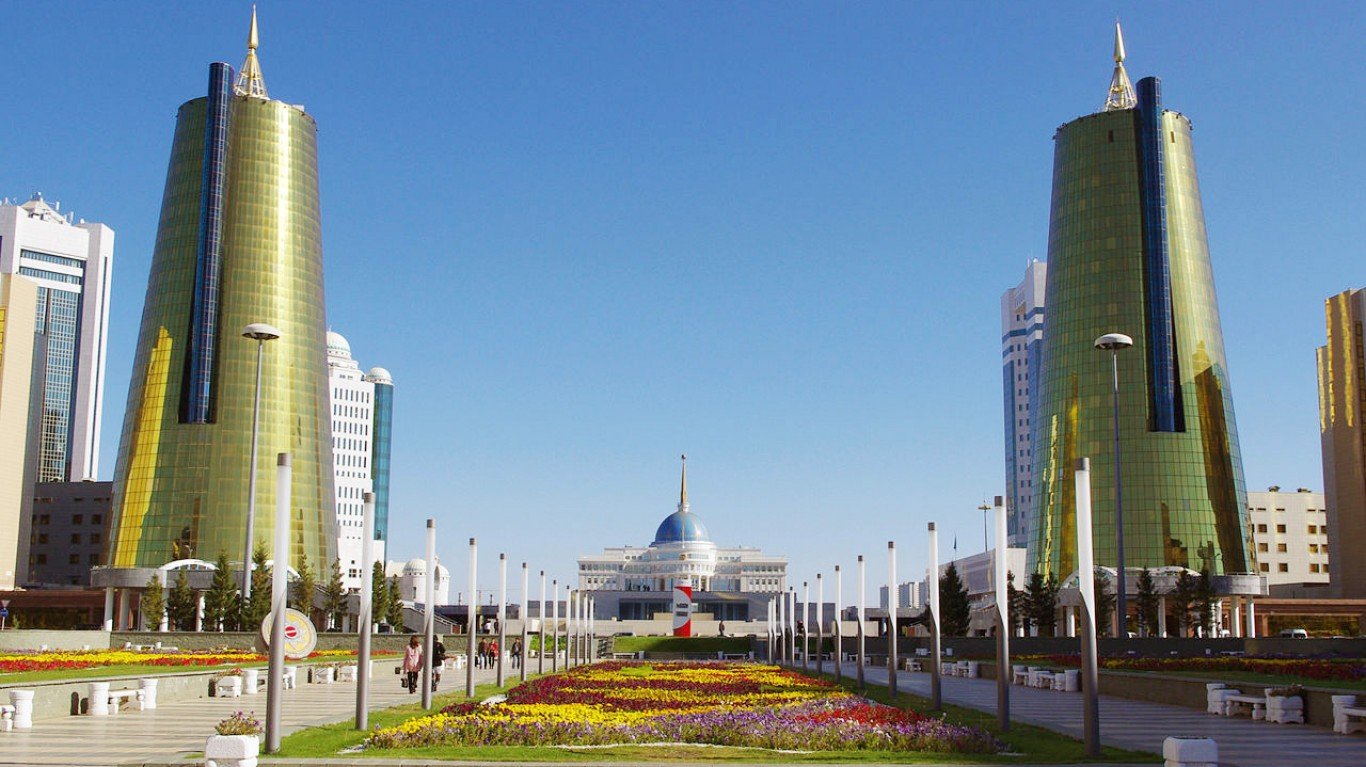
Alabama
> GDP: $192.7 billion
> Country w/ similar GDP: Kazakhstan ($196.0 billion)
> Ala. population: 4.9 million (Kazakhstan: 18.0 million)
> Ala. GDP per capita: $39,523 (Kazakhstan: $10,868)
Alabama’s economy generated nearly $192.7 billion in economic output in 2017 — nearly in line with the GDP of Kazakhstan, a former soviet country with a population more than triple that of Alabama.
Kazakhstan is geographically large — about the size of Western Europe — and resource rich. The country is a major exporter of petroleum and minerals, and China and Russia are its two biggest customers.
[in-text-ad]
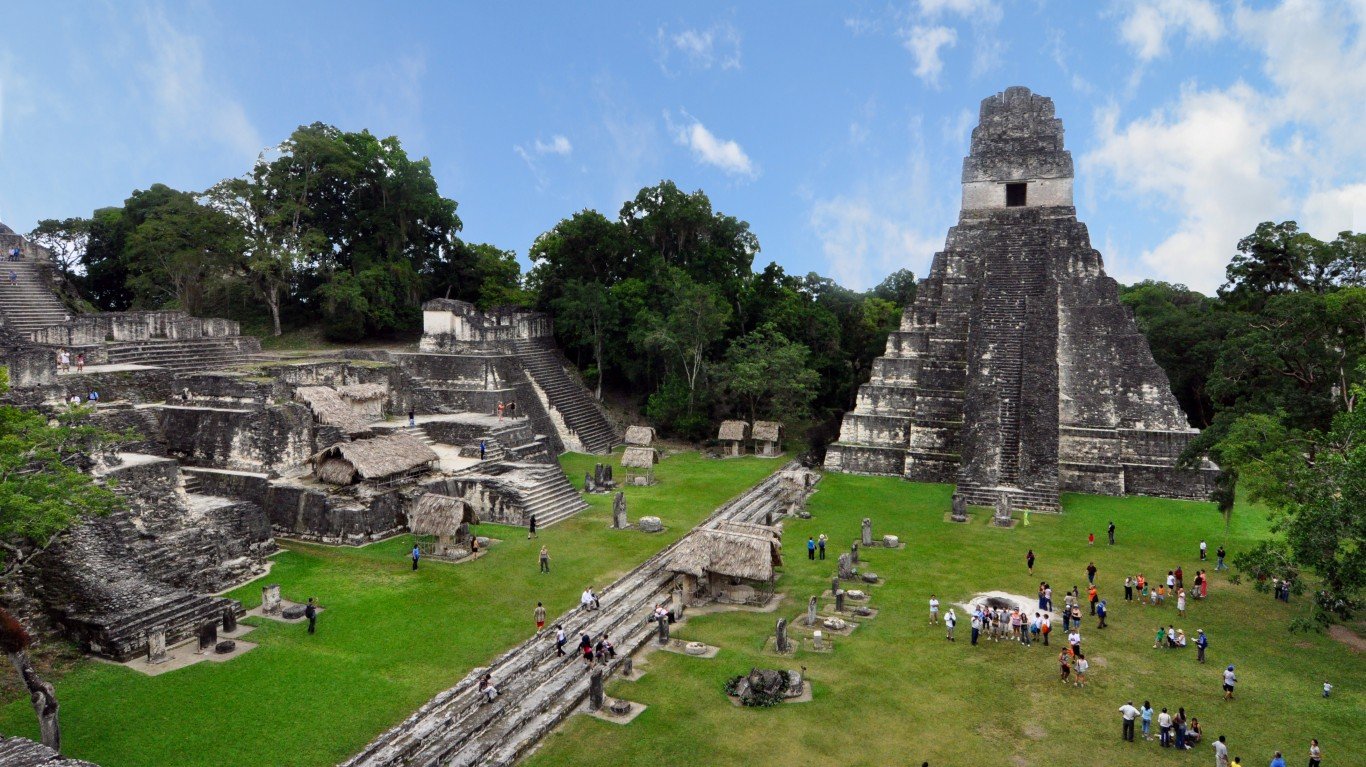
Alaska
> GDP: $52.3 billion
> Country w/ similar GDP: Guatemala ($52.8 billion)
> Alaska population: 739,795 (Guatemala: 16.9 million)
> Alaska GDP per capita: $70,683 (Guatemala: $3,124)
Alaska’s economy depends heavily on its energy sector. A resource-rich state, Alaska’s 1.6 billion barrels of proved crude oil reserves is more than all but five other states. Thanks in large part to its energy sector, Alaska’s $52.3 billion GDP is closely aligned with that of Guatemala, a country with a population nearly 23 times that of Alaska. Guatemala’s economy is largely agriculture based, with bananas and coffee as its chief agricultural exports.

Arizona
> GDP: $297.2 billion
> Country w/ similar GDP: Israel ($297.4 billion)
> Ariz. population: 7.0 million (Israel: 8.7 million)
> Ariz. GDP per capita: $42,353 (Israel: $34,135)
Arizona’s $297.2 billion economy is about the size of Israel’s economy. Arizona is far larger than our Middle Eastern ally, however, at 113,990 square miles compared to Israel’s 8,355 square miles. Arizona also has a slightly smaller population, with 7.0 million residents compared to Israel’s 8.7 million.

Arkansas
> GDP: $114.0 billion
> Country w/ similar GDP: Morocco ($119.3 billion)
> Ark. population: 3.0 million (Morocco: 35.7 million)
> Ark. GDP per capita: $37,930 (Morocco: $3,292)
Arkansas’ economy generated $114.0 billion in 2017, roughly in line with the GDP of Morocco, a North African nation with a population nearly 12 times that of Arkansas. Due in part to its close proximity to Western Europe, Morocco’s largest trading partners are Spain and France. Morocco’s top exports include fertilizers, insulated wires, and cars.
[in-text-ad-2]
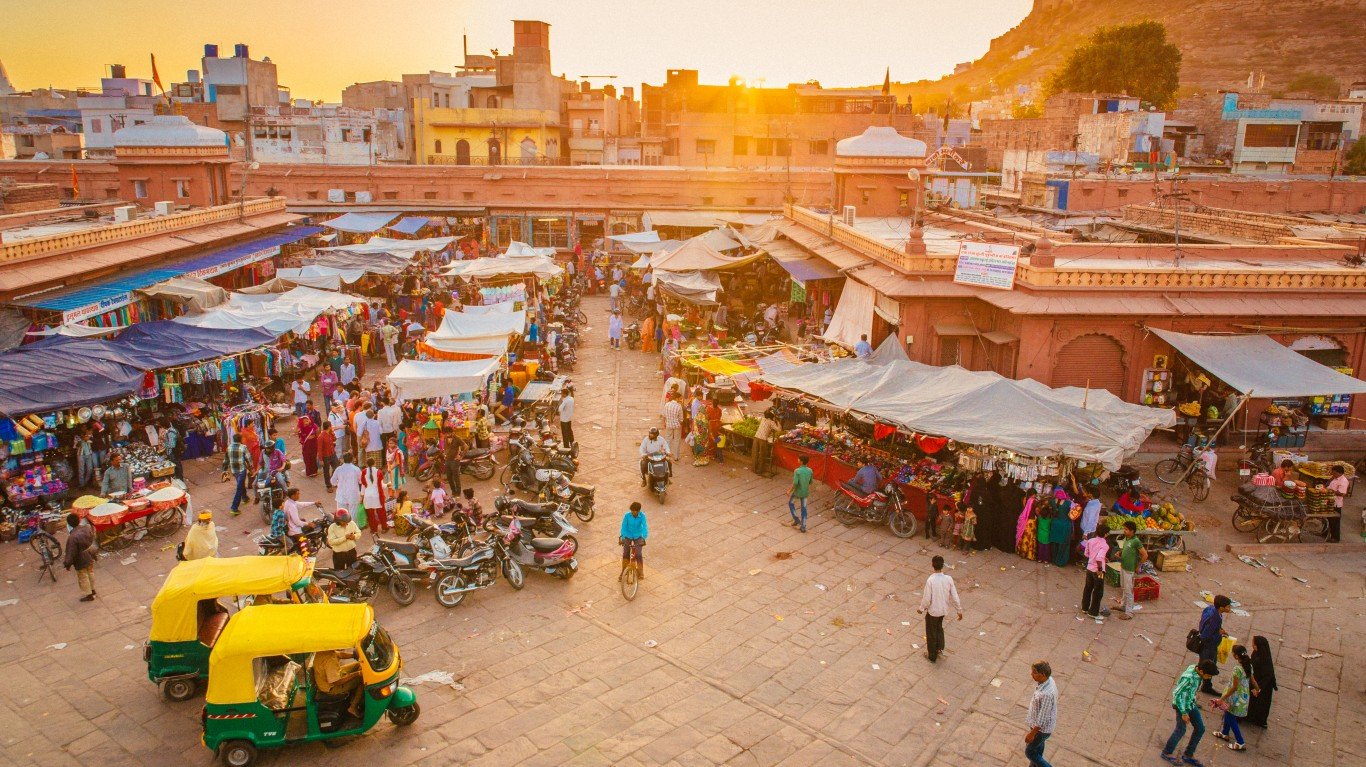
California
> GDP: $2.6 trillion
> Country w/ similar GDP: India ($2.6 trillion)
> Calif. population: 39.5 million (India: 1.3 billion)
> Calif. GDP per capita: $65,160 (India: $1,965)
California’s $2.6 trillion economy is the largest of any state. Its closest comparison on a global stage is India, which is home to 1.3 billion people, making it the second most populous country in the world by population.
California’s massive economy is bolstered by its nearly 40 million residents and a diverse range of industries, from agriculture to technology.

Colorado
> GDP: $323.3 billion
> Country w/ similar GDP: Singapore ($310.0 billion)
> Colo. population: 5.6 million (Singapore: 5.6 million)
> Colo. GDP per capita: $57,654 (Singapore: $55,236)
Of all the nations in the world, Colorado’s $323.3 billion economy most closely matches that of Singapore. Not only do Colorado and Singapore have similar GDPs, but also their population size is nearly identical at around 5.6 million.
Singapore’s economy is highly developed and relies heavily on exports of computer components.
[in-text-ad]
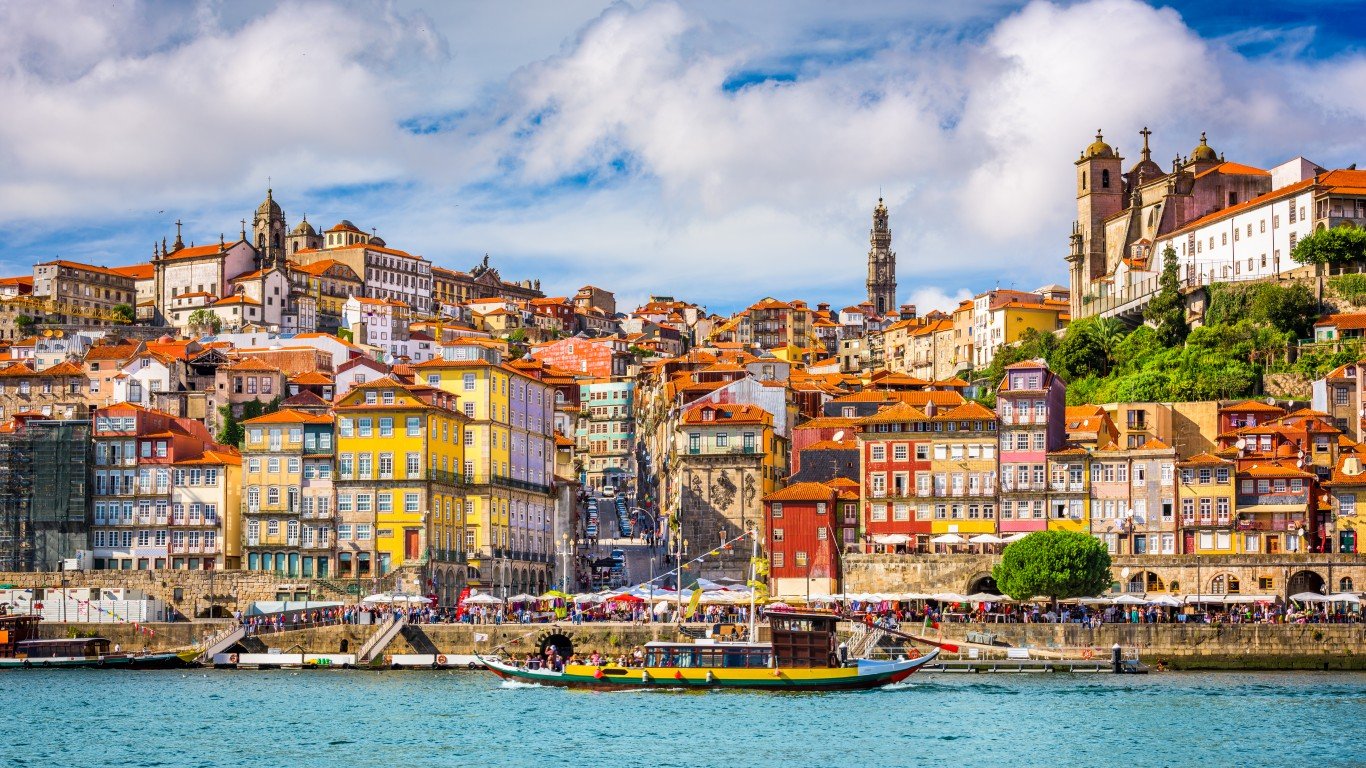
Connecticut
> GDP: $238.9 billion
> Country w/ similar GDP: Portugal ($238.0 billion)
> Conn. population: 3.6 million (Portugal: 10.3 million)
> Conn. GDP per capita: $66,592 (Portugal: $23,117)
Connecticut’s economy generated $238.9 billion in 2017, similar to the GDP of Portugal — a country with nearly three times as many people and a landmass over six times the size of the state. The unemployment rate in Portugal is estimated at 7.3%, well above Connecticut’s 2018 jobless rate of 4.1%.

Delaware
> GDP: $63.9 billion
> Country w/ similar GDP: Croatia ($63.2 billion)
> Del. population: 961,939 (Croatia: 4.1 million)
> Del. GDP per capita: $66,419 (Croatia: $15,322)
Croatia is home to four times as many people as Delaware and its landmass is nearly nine times the size of the state. Still, Croatia’s GDP of $63.2 billion is closely in line with Delaware’s $63.9 billion economy.
Delaware’s economy is advanced, with the finance, insurance, and real estate sector accounting for a far higher than average 10.3% of total employment. Croatia’s economy depends heavily on tourism, and the country ranks as one of the wealthiest former Yugoslav republics.

Florida
> GDP: $883.1 billion
> Country w/ similar GDP: Netherlands ($918.3 billion)
> Fla. population: 21.0 million (Netherlands: 17.1 million)
> Fla. GDP per capita: $42,085 (Netherlands: $53,598)
Florida’s $883.1 billion GDP is the fourth largest of all states and is relatively close to Netherlands’ GDP of $918.3 billion. Florida is an outlier on this list in that its GDP per capita of $42,085 falls below the GDP per capita of the country with most similarly sized economy — $53,598 in the Netherlands.
The Netherlands is one of the largest economies in the European Union. Largely through its chemical, petroleum refining, and highly mechanized agriculture sectors, the country — bordered by Belgium, Germany, and the North Sea — regularly maintains a trade surplus, exporting more than it is importing.
[in-text-ad-2]

Georgia
> GDP: $510.8 billion
> Country w/ similar GDP: Belgium ($524.0 billion)
> Ga. population: 10.4 million (Belgium: 11.4 million)
> Ga. GDP per capita: $48,979 (Belgium: $46,079)
Georgia’s $510.8 billion GDP is close to Belgium’s $524.0 billion GDP. The two also have similar population sizes — 10.4 million in Georgia compared to 11.4 million in Belgium. Belgium has a well-developed, diversified economy with several major sectors including services, manufacturing, and technology.

Hawaii
> GDP: $79.5 billion
> Country w/ similar GDP: Myanmar ($79.5 billion)
> Hawaii population: 1.4 million (Myanmar: 53.4 million)
> Hawaii GDP per capita: $55,668 (Myanmar: $1,490)
Home to 1.4 million people, Hawaii’s economy generated $79.5 billion in 2017, nearly the same as the GDP of Myanmar, a country with a population over 37 times that of Hawaii.
Myanmar has been racked by political instability and atrocities in recent years. Following nearly five decades of oppressive military rule, the country held free elections in 2015, only to draw international condemnation two years later for what has been deemed ethnic cleansing of the country’s Rohingya Muslim population.
[in-text-ad]

Idaho
> GDP: $67.0 billion
> Country w/ similar GDP: Uzbekistan ($65.8 billion)
> Idaho population: 1.7 million (Uzbekistan: 32.4 million)
> Idaho GDP per capita: $39,032 (Uzbekistan: $2,031)
Idaho had a $67.0 billion GDP in 2017, in line with the GDP of Uzbekistan, a country with nearly 19 times more people than Idaho’s population of 1.7 million.
Uzbekistan gained independence after the collapse of the Soviet Union in 1991, but it still has a state-controlled economy. The country’s chief exports include cotton, gas, and gold.

Illinois
> GDP: $745.3 billion
> Country w/ similar GDP: Saudi Arabia ($684.2 billion)
> Ill. population: 12.8 million (Saudi Arabia: 32.9 million)
> Ill. GDP per capita: $58,217 (Saudi Arabia: $20,771)
Of all the national economies in the world, Illinois’ $745.3 billion economy most closely matches that of Saudi Arabia. Saudi Arabia’s economy is built on the back of its oil exports, and the country is a founding member of the Organization of Petroleum Exporting Countries, or OPEC.

Indiana
> GDP: $321.1 billion
> Country w/ similar GDP: Singapore ($310.0 billion)
> Ind. population: 6.7 million (Singapore: 5.6 million)
> Ind. GDP per capita: $48,170 (Singapore: $55,236)
Indiana’s $321.1 billion economy is only slightly larger than Singapore’s $310.0 billion economy. Indiana, however, is also many times the size of Singapore and home to over a million more people. As a result, Singapore is more productive on a per capita basis. Singapore has a highly developed economy and is a global financial hub.
[in-text-ad-2]
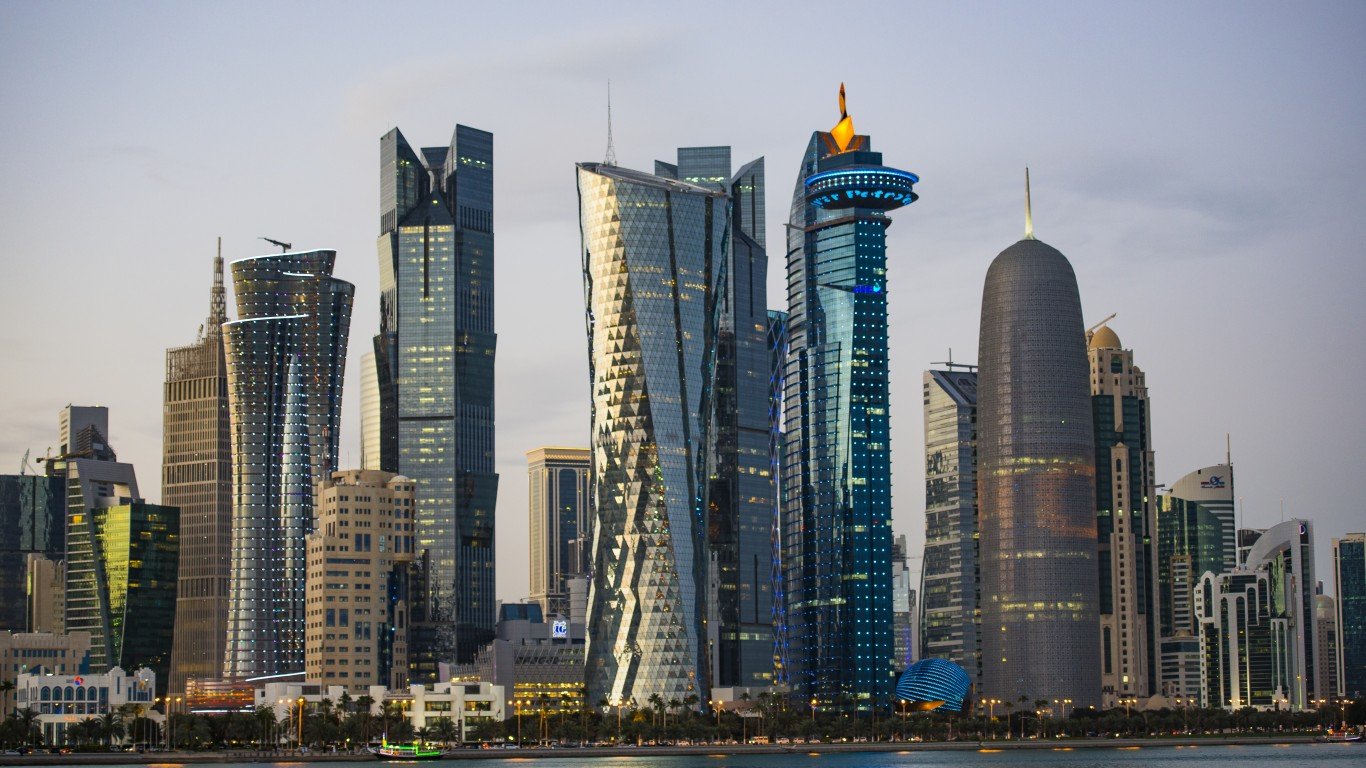
Iowa
> GDP: $169.2 billion
> Country w/ similar GDP: Qatar ($173.4 billion)
> Iowa population: 3.1 million (Qatar: 2.6 million)
> Iowa GDP per capita: $53,798 (Qatar: $65,694)
Qatar’s $173.4 billion GDP is only slightly higher than Iowa’s $169.2 billion GDP — even though it is home to half a million fewer people than the Midwestern state. Qatar, an oil-rich Middle Eastern nation is one of the wealthiest countries in the world, with a GDP per capita of $65,694. For reference, Iowa’s GDP per capita is just $53,798.
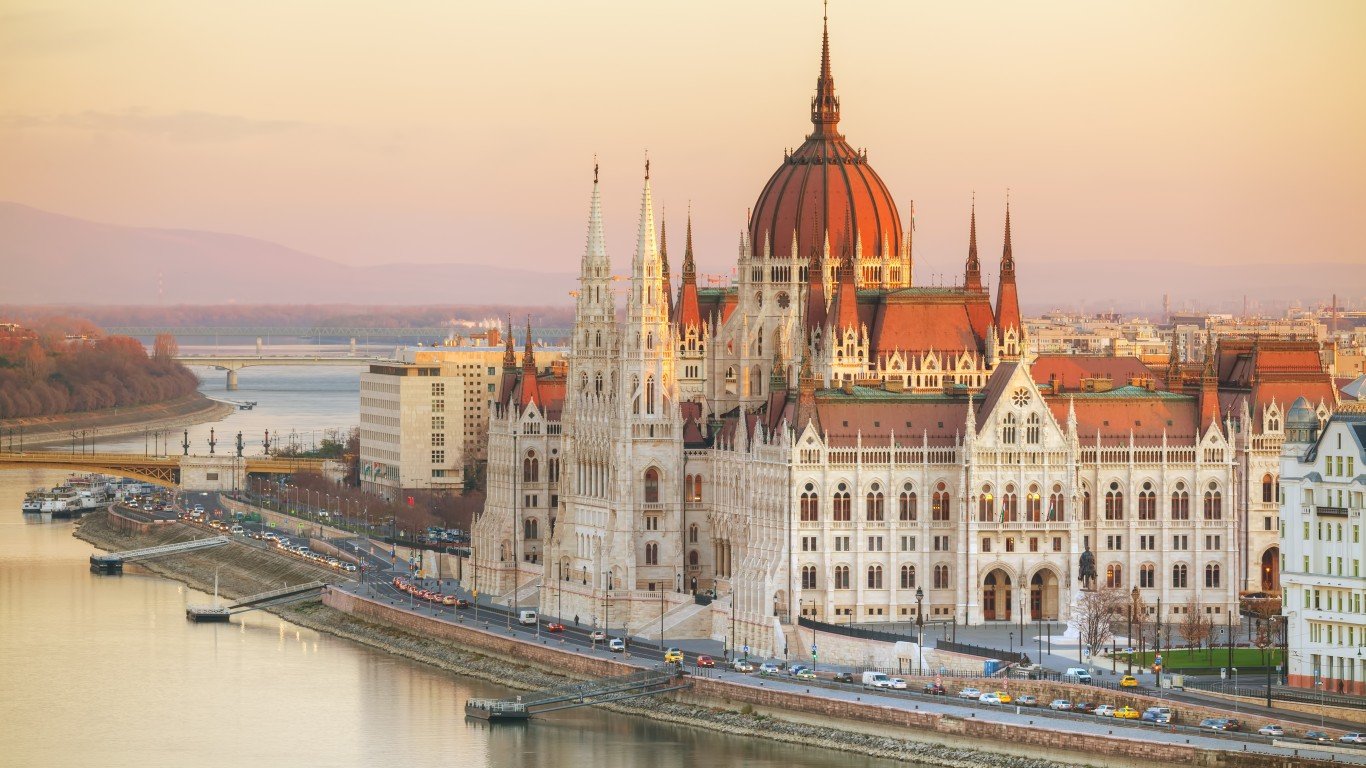
Kansas
> GDP: $148.5 billion
> Country w/ similar GDP: Hungary ($153.1 billion)
> Kan. population: 2.9 million (Hungary: 9.8 million)
> Kan. GDP per capita: $50,970 (Hungary: $15,648)
Hungary is home to 9.8 million people, more than triple the population of Kansas. Despite a larger population, Hungary and Kansas have similarly sized economies, at $153.1 billion and $148.5 billion, respectively.
Fighting for the Axis powers in WWII and occupied by Soviets until 1991, Hungary is now a democracy and member state of NATO and the EU — the latter of which has been a boon for the country’s economic development.
[in-text-ad]

Kentucky
> GDP: $184.7 billion
> Country w/ similar GDP: New Zealand ($181.5 billion)
> Ky. population: 4.5 million (New Zealand: 4.8 million)
> Ky. GDP per capita: $41,463 (New Zealand: $37,853)
Kentucky generated $184.7 billion in economic output in 2017, closely in line with New Zealand’s $181.5 billion GDP. Kentucky’s population of 4.5 million is also closely aligned with New Zealand’s 4.8 million residents. New Zealand’s economy is driven largely by agriculture, tourism, and manufacturing.
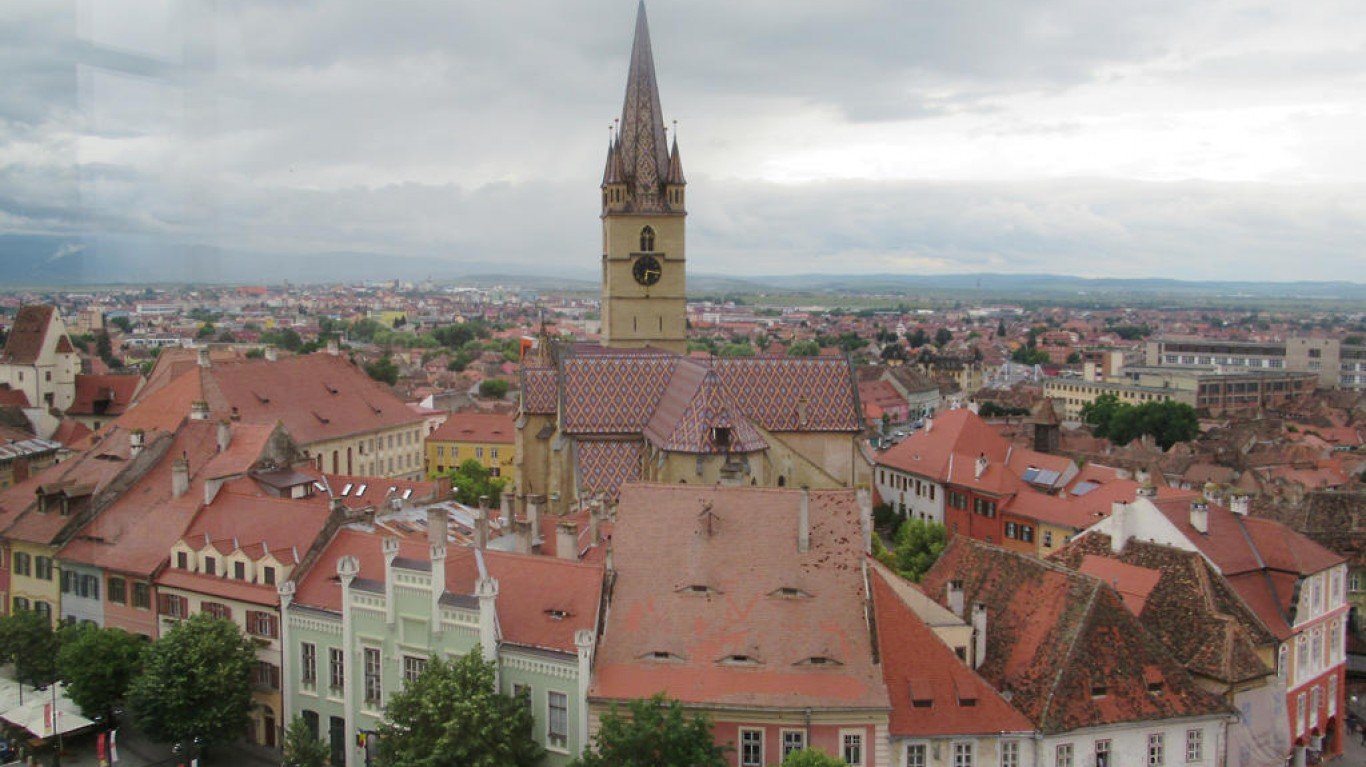
Louisiana
> GDP: $226.6 billion
> Country w/ similar GDP: Romania ($216.3 billion)
> La. population: 4.7 million (Romania: 19.6 million)
> La. GDP per capita: $48,377 (Romania: $11,045)
Of all the national economies in the world, Romania’s is the closest in size to that of Louisiana — despite having a population over four times the size of Louisiana. The southeastern European country’s GDP is $216.3 billion, and Louisiana’s is $226.6 billion.
Louisiana’s economy relies heavily on its energy sector. The 17 oil refineries in the state can process up to 3.3 million barrels of crude oil a day and account for about 20% of Americacn refining capacity.
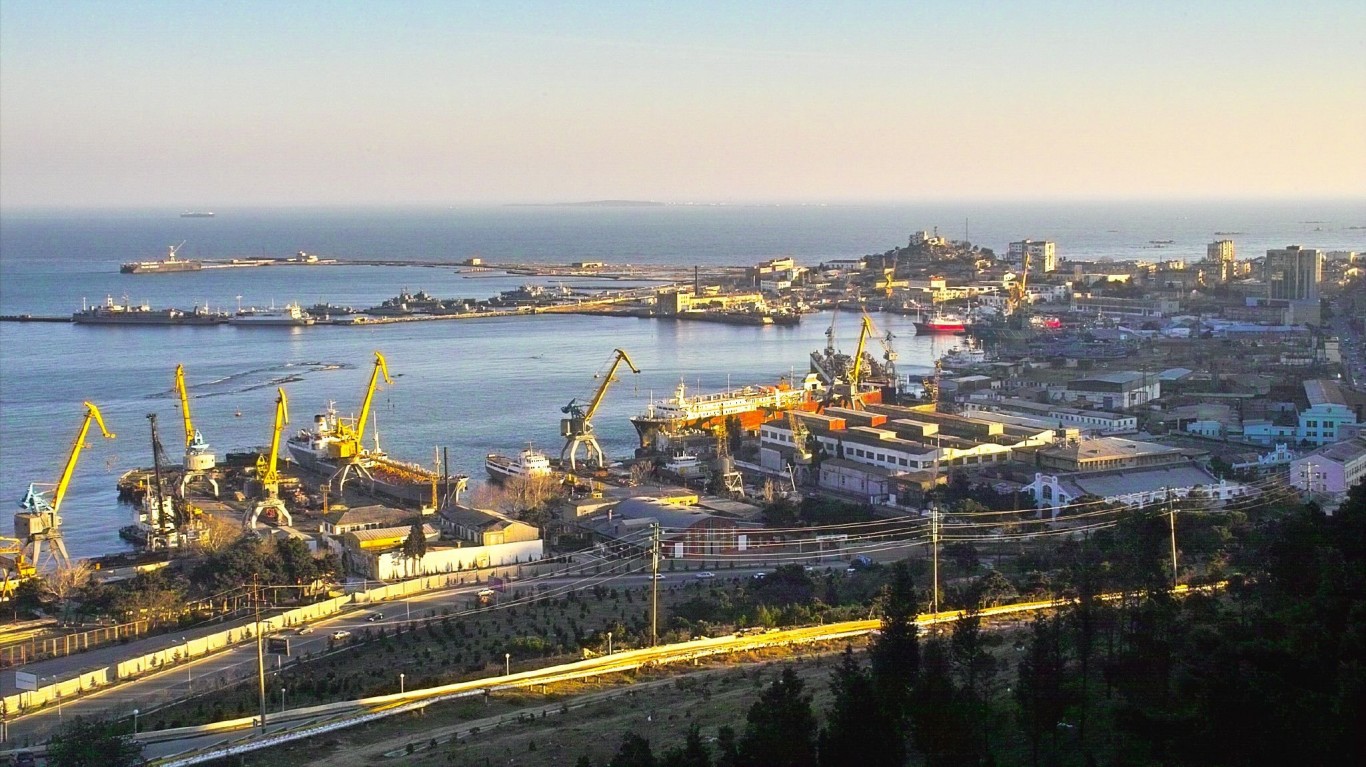
Maine
> GDP: $55.6 billion
> Country w/ similar GDP: Azerbaijan ($57.3 billion)
> Maine population: 1.3 million (Azerbaijan: 9.9 million)
> Maine GDP per capita: $41,619 (Azerbaijan: $5,805)
Maine’s economy generated $55.6 billion in 2017, roughly the same as Azerbaijan, a country with a population more than seven times that of the northern New England state. Azerbaijan’s economy benefits from its oil reserves, but economic growth has been stifled in recent years by corruption. Poverty also remains a considerable challenge in the country.
[in-text-ad-2]

Maryland
> GDP: $363.0 billion
> Country w/ similar GDP: Malaysia ($364.6 billion)
> Md. population: 6.1 million (Malaysia: 31.6 million)
> Md. GDP per capita: $59,983 (Malaysia: $11,528)
Home to 31.6 million people, the Southeast Asian nation of Malaysia is over five times more populous than Maryland, a state with 6.1 million people. By GDP, however, the two are more closely matched. Maryland’s $363.0 billion economy is only slightly smaller than Malaysia’s $364.6 billion economy. Malaysia has a large tourism industry and is benefitting from a growing manufacturing sector.

Massachusetts
> GDP: $490.2 billion
> Country w/ similar GDP: Norway ($481.8 billion)
> Mass. population: 6.9 million (Norway: 5.3 million)
> Mass. GDP per capita: $71,456 (Norway: $91,219)
Massachusetts has a $490.2 billion economy, about the same size as Norway’s. One of the wealthiest states in the country, Massachusetts has a GDP per capita of $71,456. However, because Norway is home to about 1.6 million fewer people than Massachusetts, its GDP per capita is even higher, at $91,219. The country’s wealth is partially due to the discovery of oil offshore in the 1960s. Today, Norway is the seventh largest oil exporter in the world.
[in-text-ad]
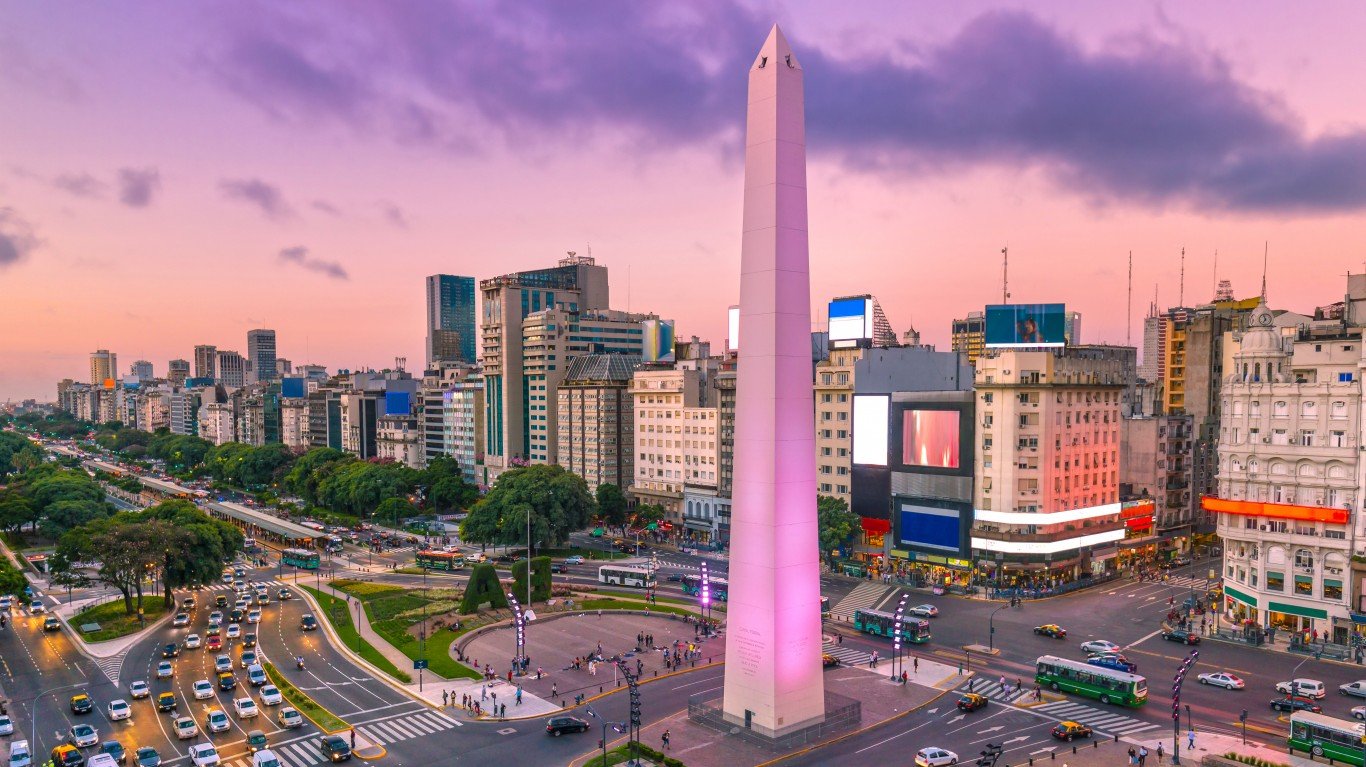
Michigan
> GDP: $458.8 billion
> Country w/ similar GDP: Argentina ($460.3 billion)
> Mich. population: 10.0 million (Argentina: 44.3 million)
> Mich. GDP per capita: $46,055 (Argentina: $10,397)
Michigan has a $458.8 billion GDP, roughly in line with the economic output of the South American nation of Argentina. Home of the American auto industry, Michigan has a strong manufacturing sector that employs nearly one in every five workers in the state, a larger share than in any other state. Argentina’s economy is heavily dependent on agricultural exports like soybeans and soybean meal, corn, and wheat.
Minnesota
> GDP: $322.4 billion
> Country w/ similar GDP: Singapore ($310.0 billion)
> Minn. population: 5.6 million (Singapore: 5.6 million)
> Minn. GDP per capita: $57,809 (Singapore: $55,236)
Like Colorado, Indiana, and Tennessee, Minnesota’s economy is similar in size to that of Singapore — $322.4 billion compared to $310.0 billion, respectively.
Minnesota is one of the larger states by landmass, while Singapore is a small island city-state less than one-three-hundredth the state’s size. Still, their populations closely align, as they are each home to some 5.6 million people.
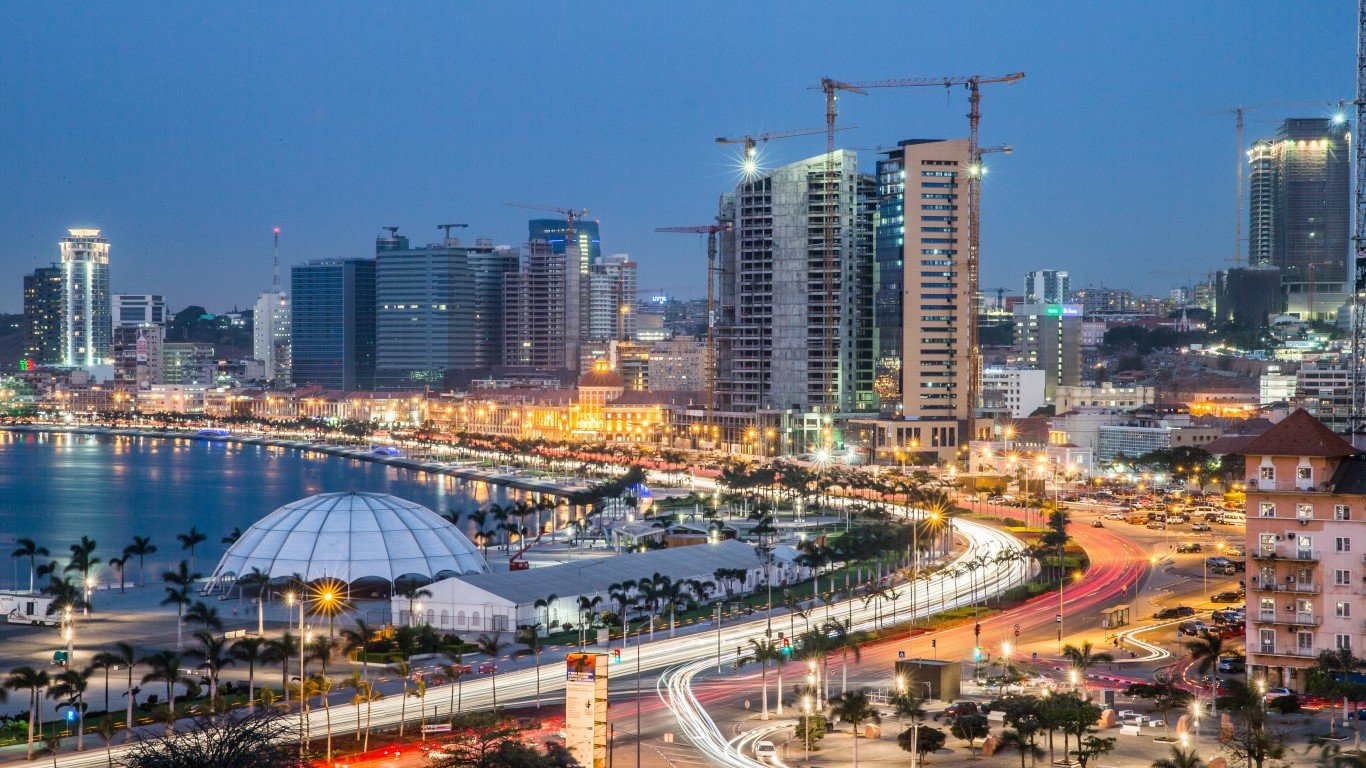
Mississippi
> GDP: $100.1 billion
> Country w/ similar GDP: Angola ($101.7 billion)
> Miss. population: 3.0 million (Angola: 29.8 million)
> Miss. GDP per capita: $33,558 (Angola: $3,414)
Mississippi’s $100.1 billion in economic output in 2017 closely matches the GDP of the African nation Angola. Though their economies are roughly the same size, Angola is home to nearly 30 million people, 10 times Mississippi’s population. Angola is an oil-rich country, but much of that wealth is located in a contested region partially held by separatists.
[in-text-ad-2]
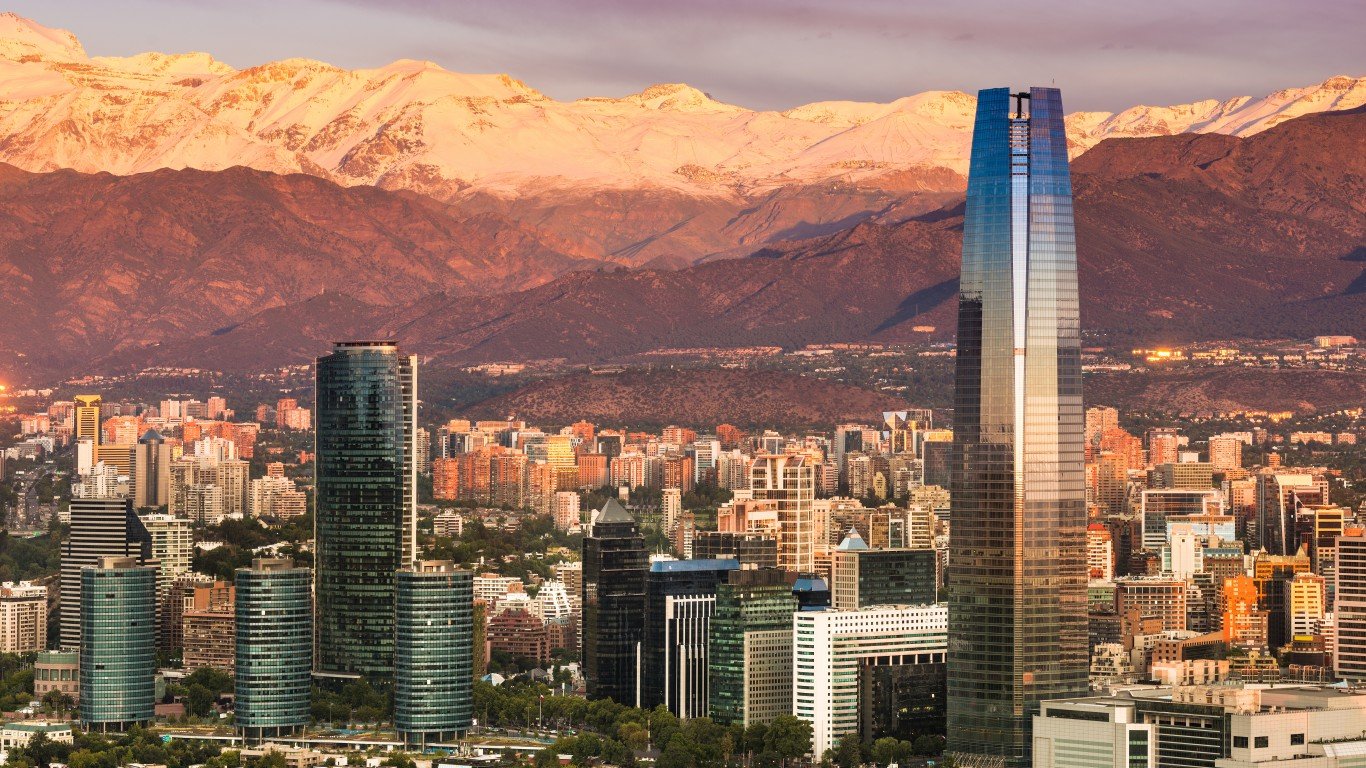
Missouri
> GDP: $275.6 billion
> Country w/ similar GDP: Chile ($271.9 billion)
> Mo. population: 6.1 million (Chile: 18.1 million)
> Mo. GDP per capita: $45,076 (Chile: $15,060)
Missouri’s $275.6 billion GDP most closely matches that of Chile, though the South American country has nearly three times the population of the Show Me State. Chile derives much of its wealth from natural resources, primarily copper. Nearly half of the country’s $70.1 billion in exports in were copper, copper ore, and refined copper. A coastal country, Chile also exports seafood and wine.

Montana
> GDP: $44.4 billion
> Country w/ similar GDP: Lebanon ($43.2 billion)
> Mont. population: 1.1 million (Lebanon: 6.1 million)
> Mont. GDP per capita: $42,276 (Lebanon: $7,103)
Montana, home to just over 1 million people, has a $44.4 billion economy — similar in size to the economy of Lebanon, a country of over 6 million people. Situated along the Mediterranean’s eastern shore, Lebanon has long been a regional trading hub. However, it also shares borders with Israel and Syria and has been involved in armed conflicts. It has also been a refuge for people and groups displaced by violence.
[in-text-ad]
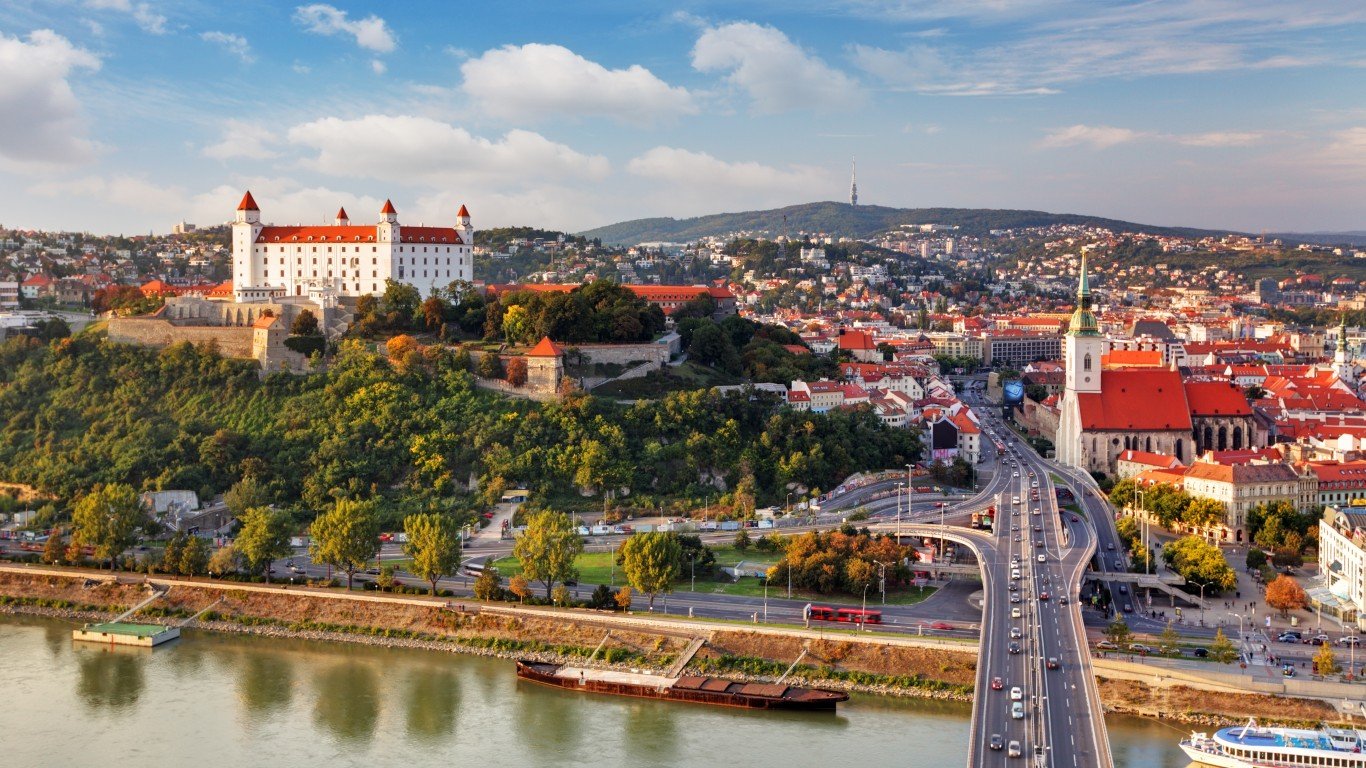
Nebraska
> GDP: $111.5 billion
> Country w/ similar GDP: Slovak Republic ($108.2 billion)
> Neb. population: 1.9 million (Slovak Republic: 5.4 million)
> Neb. GDP per capita: $58,053 (Slovak Republic: $19,897)
Nebraska’s 1.9 million residents produce an economic output of over $111 billion, close to that of the Slovak Republic, or Slovakia. The country’s economy centers around manufacturing, with more than a quarter of exports in 2017 in vehicles or vehicle parts. Though Nebraska has a much smaller population than the Slovak Republic, its landmass is more than four times that of the European nation.
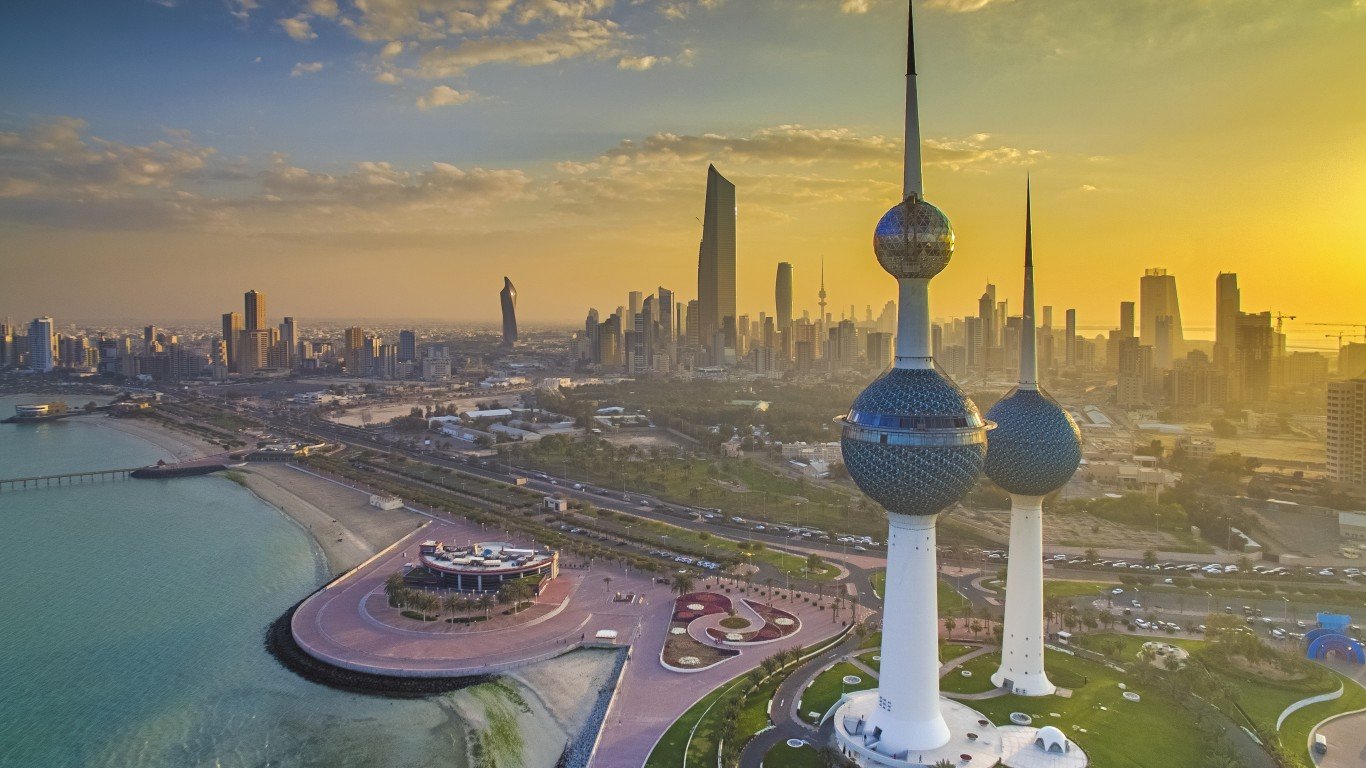
Nevada
> GDP: $142.9 billion
> Country w/ similar GDP: Kuwait ($138.8 billion)
> Nev. population: 3.0 million (Kuwait: 4.1 million)
> Nev. GDP per capita: $47,648 (Kuwait: $33,546)
Nevada’s economy generated $142.9 billion in 2017, nearly the same as the Middle Eastern nation of Kuwait — which happens to be one of the wealthiest nations in both the region and the world. Kuwait has a relatively open political system for the region, and it has more proved oil reserves than all but a handful of other countries worldwide.
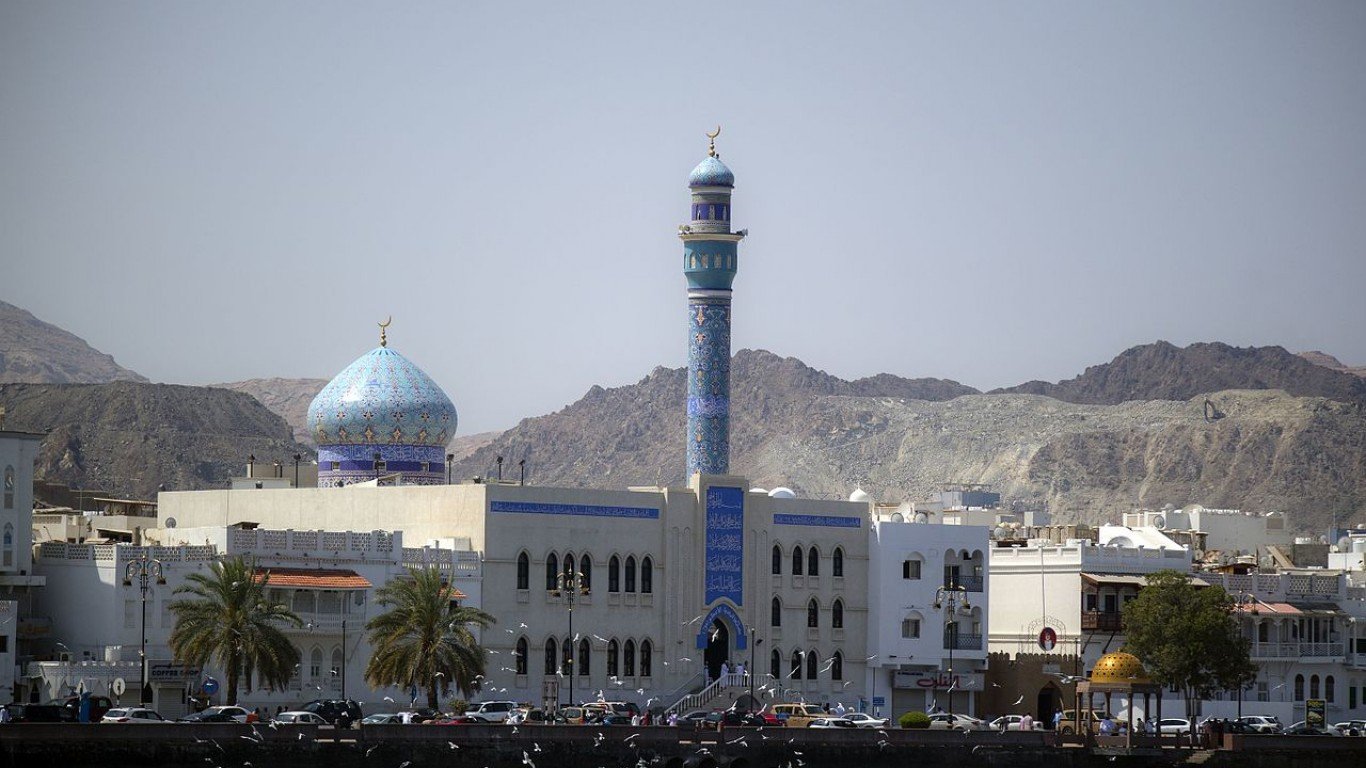
New Hampshire
> GDP: $74.4 billion
> Country w/ similar GDP: Oman ($74.8 billion)
> N.H. population: 1.3 million (Oman: 4.6 million)
> N.H. GDP per capita: $55,413 (Oman: $16,144)
One of the smallest states by population, New Hampshire has a $74.4 billion economy — on par with Oman, a Middle Eastern nation with a population more than triple that of New Hampshire. Like other countries in the region, Oman relies heavily on exports of crude oil and petroleum products.
[in-text-ad-2]
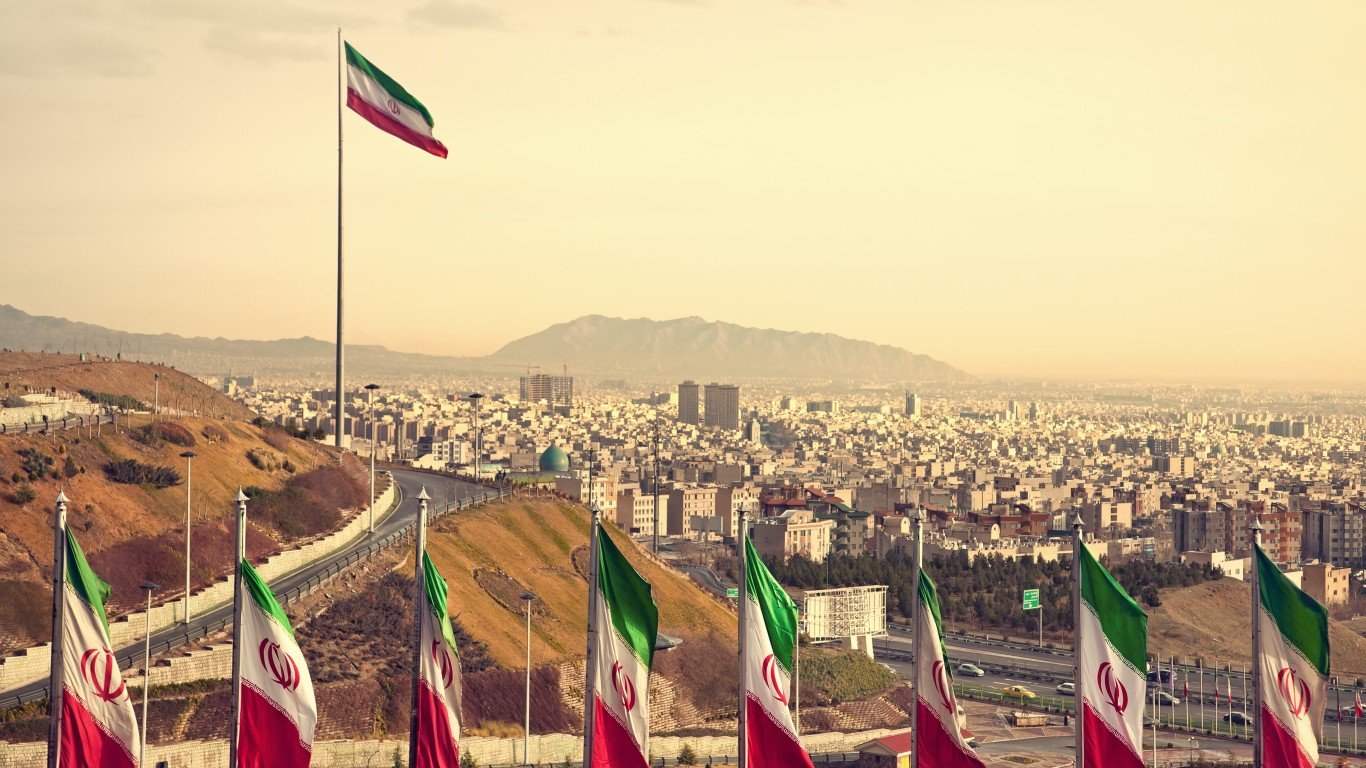
New Jersey
> GDP: $546.5 billion
> Country w/ similar GDP: Iran, Islamic Rep. ($560.9 billion)
> N.J. population: 9.0 million (Iran, Islamic Rep.: 81.2 million)
> N.J. GDP per capita: $60,684 (Iran, Islamic Rep.: $6,911)
New Jersey has a similar economic output to Iran, even though the Middle Eastern country has about nine times as many residents and 72 times as much land. Nearly three-quarters of Iran’s 2017 exports, worth roughly $54 billion, are in petroleum. Conversely, a relatively small amount of New Jersey’s economic output comes from natural resources. Instead, the state has some of the largest shares of workers employed in the information and finance industries.
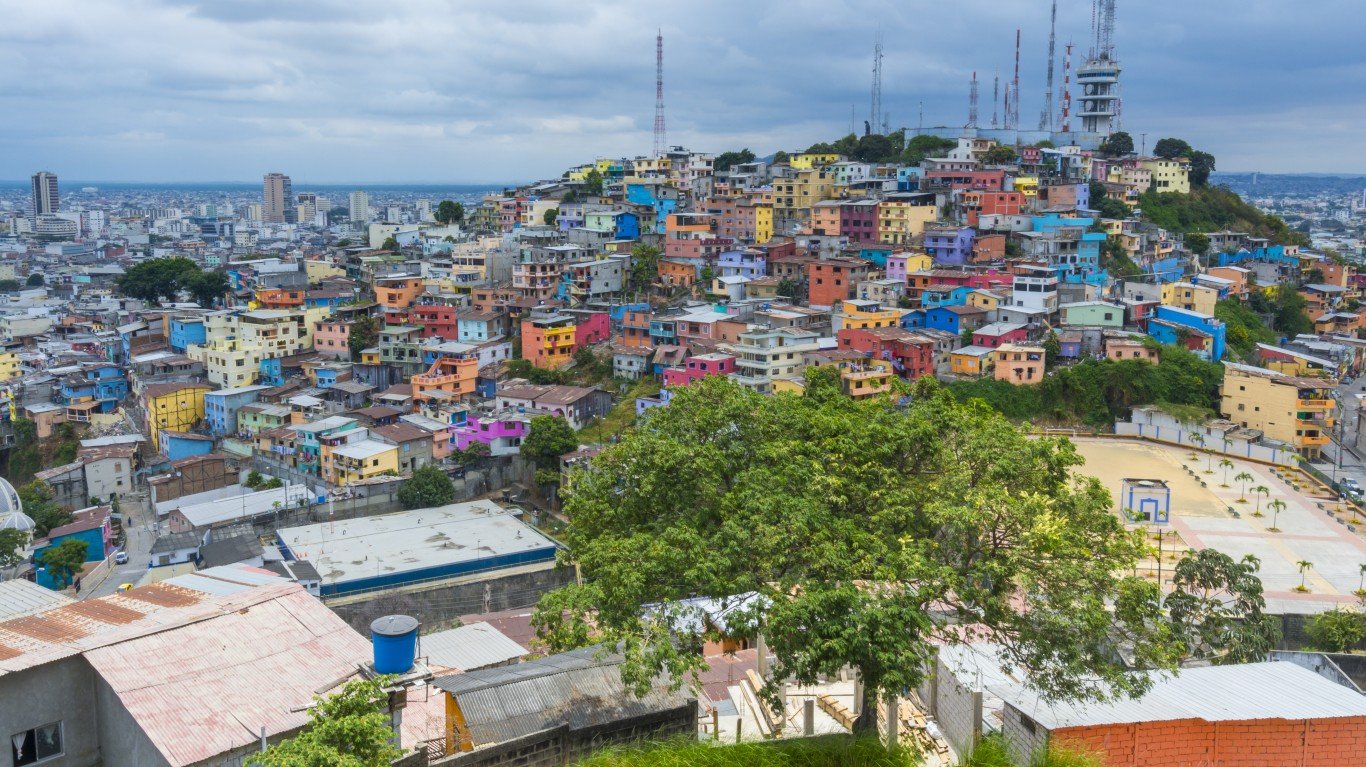
New Mexico
> GDP: $91.0 billion
> Country w/ similar GDP: Ecuador ($87.4 billion)
> N.M. population: 2.1 million (Ecuador: 16.6 million)
> N.M. GDP per capita: $43,566 (Ecuador: $5,256)
New Mexico has a GDP of $91.0 billion, in line with the GDP of the South American nation of Ecuador. New Mexico’s economy relies on industries like agriculture, forestry, mining, and arts, entertainment, and accommodation, which employ a larger than typical share of workers in the state. Meanwhile, Ecuador’s economy depends heavily on petroleum exports and suffered in recent years from falling oil prices.
[in-text-ad]

New York
> GDP: $1.4 trillion
> Country w/ similar GDP: Australia ($1.4 trillion)
> N.Y. population: 19.8 million (Australia: 24.6 million)
> N.Y. GDP per capita: $71,252 (Australia: $55,926)
New York state, home to one of the financial capitals of the world, is one of three states with an economic output that exceeds $1 trillion. It closely matches the GDP of Australia. More than half of Australia’s $243 billion in exports came from minerals and natural resources like iron, gold, coal, and petroleum. Australia’s GDP per capita of $55,926 is lower than New York’s GDP per capita but is very close to the U.S. GDP per capita of $55,418.

North Carolina
> GDP: $484.3 billion
> Country w/ similar GDP: Norway ($481.8 billion)
> N.C. population: 10.3 million (Norway: 5.3 million)
> N.C. GDP per capita: $47,142 (Norway: $91,219)
The size of North Carolina’s economy, like that of Massachusetts and Washington, is closest to that of Norway’s. As one of the world’s largest oil exporters, the Northern European country, home to about half as many people as North Carolina, has a GDP per capita of more than $91,000, nearly double the per capita economic output of North Carolina.
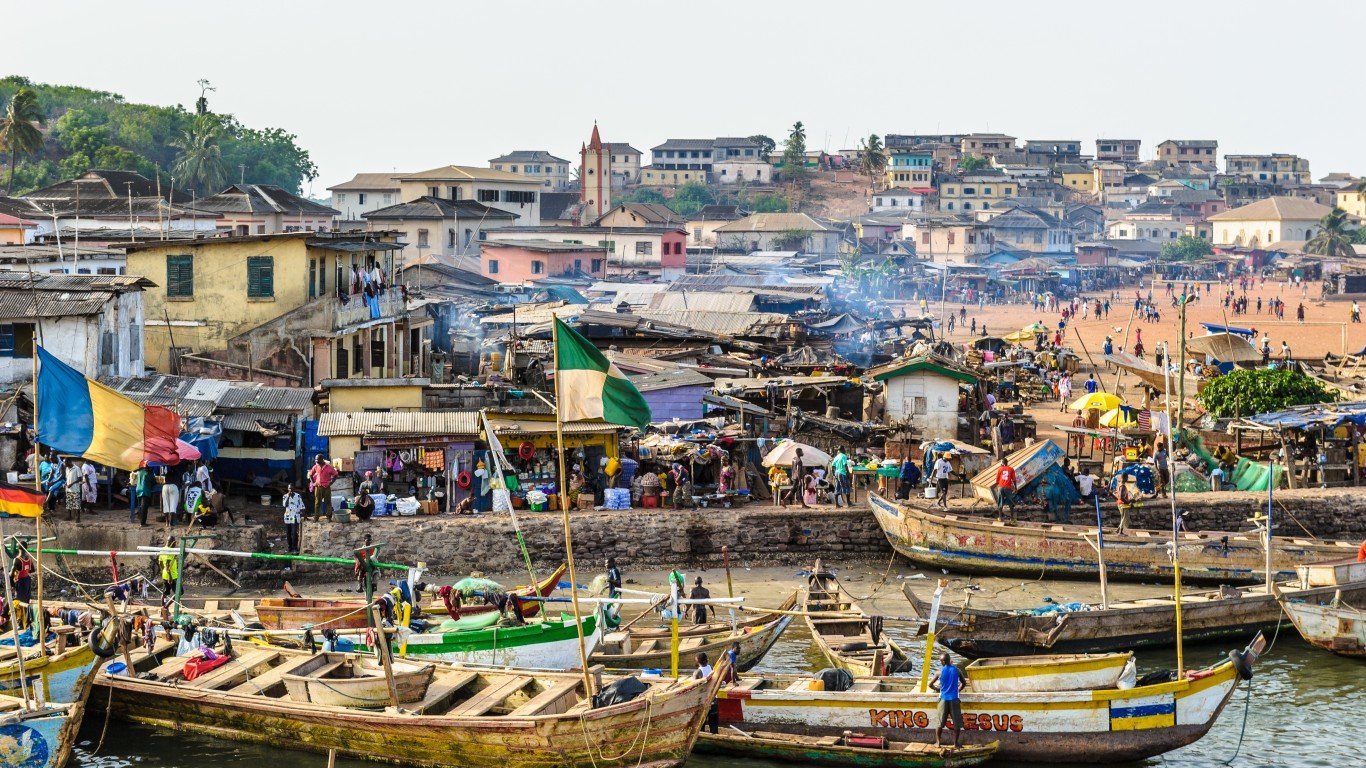
North Dakota
> GDP: $50.8 billion
> Country w/ similar GDP: Ghana ($50.6 billion)
> N.D. population: 755,393 (Ghana: 28.8 million)
> N.D. GDP per capita: $67,244 (Ghana: $1,756)
North Dakota’s economy is roughly the size of the entire African nation of Ghana. North Dakota’s economy is heavily dependent on resource extraction, an industry that flourished in the last 10 years due to new developments in hydrofracking methods — methods that allow for the extraction of natural gas in the state’s Bakken Formation.
Resource extraction is also a pillar of Ghana’s far less diversified economy. Ghana’s major exports include oil, gold, and cocoa.
[in-text-ad-2]
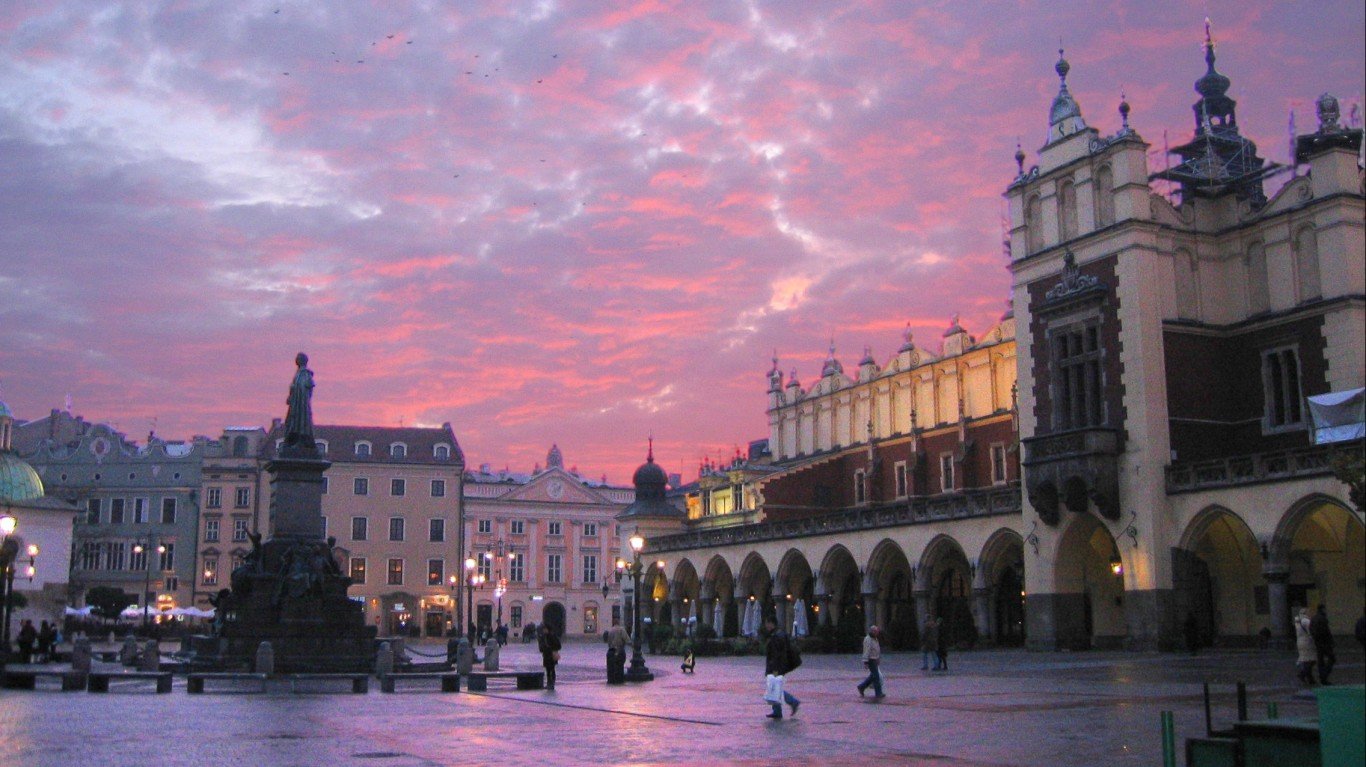
Ohio
> GDP: $590.7 billion
> Country w/ similar GDP: Poland ($600.9 billion)
> Ohio population: 11.7 million (Poland: 38.0 million)
> Ohio GDP per capita: $50,666 (Poland: $15,823)
Poland has the sixth largest economy in the European Union with a GDP of just over $600 billion, roughly in line with Ohio’s GDP. Both economies are largely focused on manufacturing — more than 40% of Poland’s exports are manufactured goods like cars and computers. More than 15% of Ohio workers are employed in the manufacturing sector compared to 10.1% of workers nationwide.
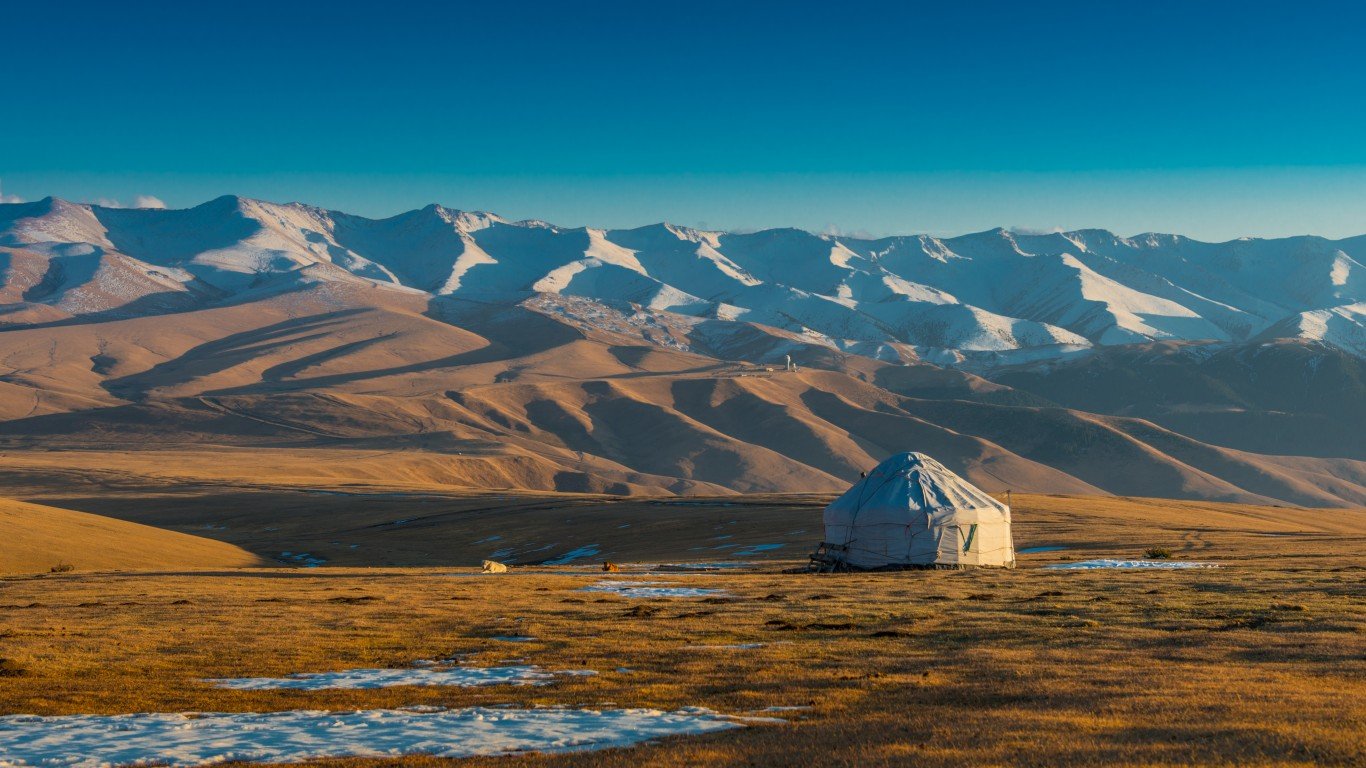
Oklahoma
> GDP: $190.9 billion
> Country w/ similar GDP: Kazakhstan ($196.0 billion)
> Okla. population: 3.9 million (Kazakhstan: 18.0 million)
> Okla. GDP per capita: $48,569 (Kazakhstan: $10,868)
The sixth largest producer of crude oil and fourth largest producer of natural gas, Oklahoma’s $190.9 billion economy is heavily dependent on energy production. Kazakhstan, a country 15 times the size of Oklahoma by landmass and nearly five times as large by population, has a similarly sized economy. A former Soviet republic, Kazakhstan’s economy is heavily dependent on agriculture and extraction of oil and minerals, including copper and zinc.
[in-text-ad]
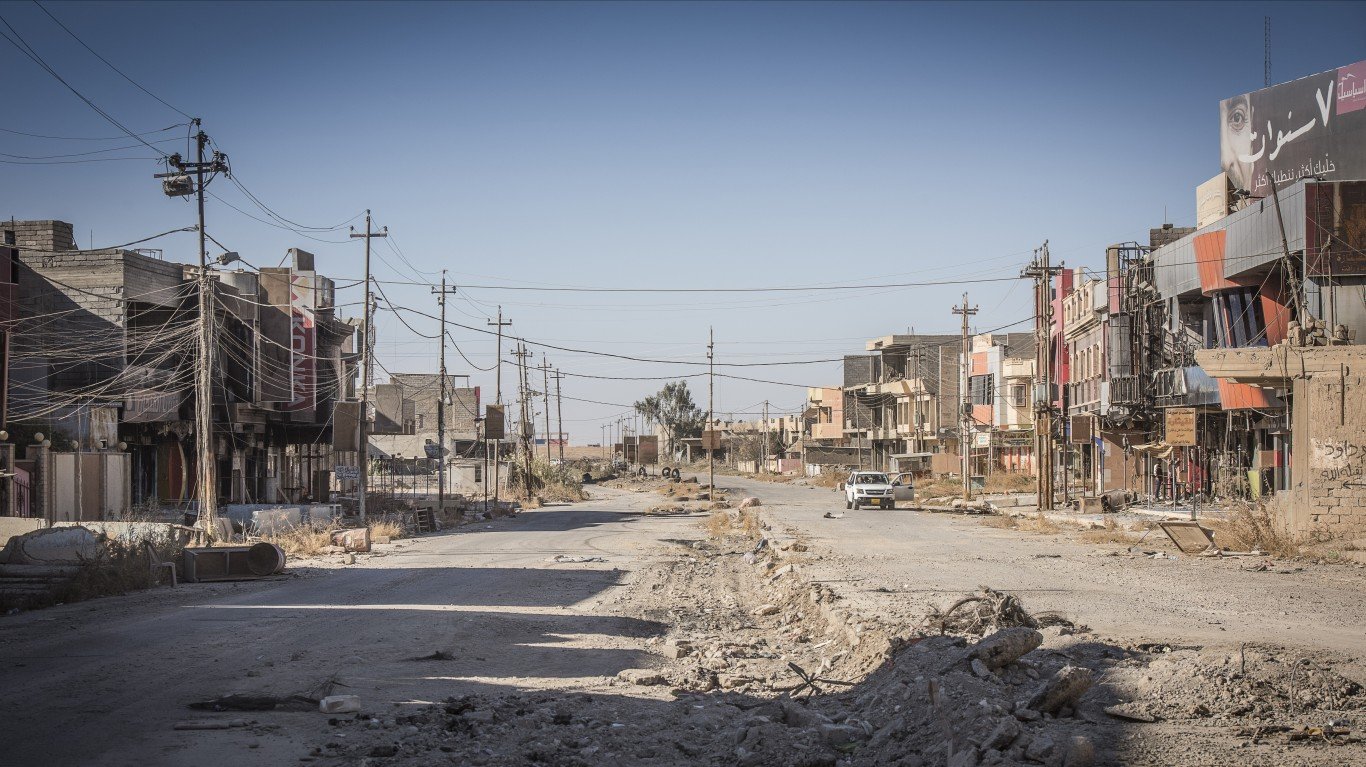
Oregon
> GDP: $207.7 billion
> Country w/ similar GDP: Iraq ($208.6 billion)
> Ore. population: 4.1 million (Iraq: 38.3 million)
> Ore. GDP per capita: $50,138 (Iraq: $5,450)
Though Iraq is not often considered an economic powerhouse, it has a GDP of over $200 billion — very similar to Oregon’s economic output. Iraq has about nine times as many people as Oregon, however, meaning its GDP per capita is about one-ninth of Oregon’s. A war-torn country for most of the 21st century, first with the United States then ISIS, Iraq has relied on oil to keep its economy afloat. Of the country’s $60.8 billion in exports, 95% are crude petroleum.

Pennsylvania
> GDP: $700.8 billion
> Country w/ similar GDP: Saudi Arabia ($684.2 billion)
> Pa. population: 12.8 million (Saudi Arabia: 32.9 million)
> Pa. GDP per capita: $54,725 (Saudi Arabia: $20,771)
Pennsylvania’s GDP is the closest to that of the petroleum-rich nation Saudi Arabia. More than three-quarters of Saudi Arabia’s exports are oil-related — either in crude, refined, or gas form. Though Saudi Arabia and Pennsylvania have similarly sized economies, the Middle Eastern country has a larger population by over 20 million. As a result, the per capita GDP of Saudi Arabia is significantly smaller than Pennsylvania’s.
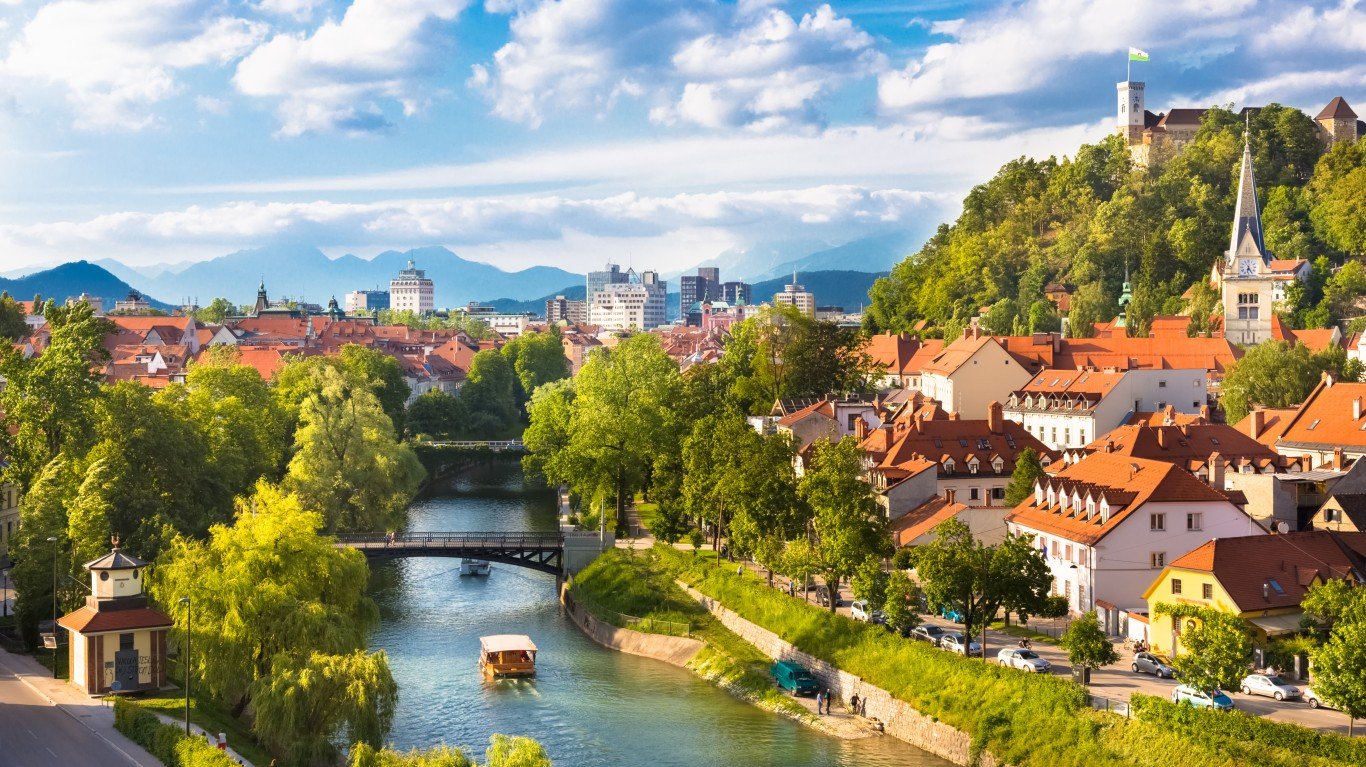
Rhode Island
> GDP: $53.5 billion
> Country w/ similar GDP: Slovenia ($53.0 billion)
> R.I. population: 1.1 million (Slovenia: 2.1 million)
> R.I. GDP per capita: $50,446 (Slovenia: $25,662)
Rhode Island’s $53.5 billion GDP is about the same as the GDP of Slovenia, a country with nearly twice as many people. Though Slovenia’s transition to a market economy following the breakup of Yugoslavia was relatively smooth, the 2012 European financial crisis and ensuing years of fiscal mismanagement have stymied economic growth in the country.
[in-text-ad-2]
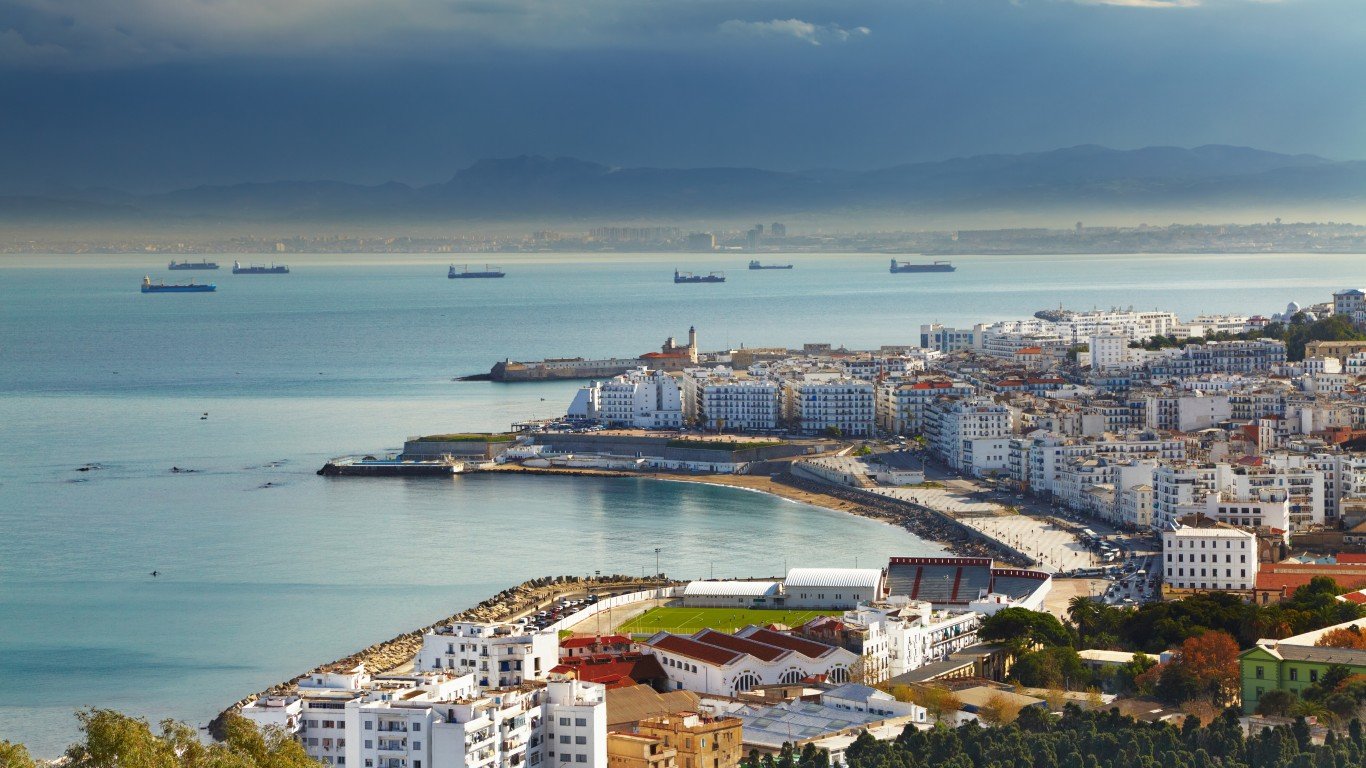
South Carolina
> GDP: $199.3 billion
> Country w/ similar GDP: Algeria ($199.2 billion)
> S.C. population: 5.0 million (Algeria: 41.3 million)
> S.C. GDP per capita: $39,673 (Algeria: $4,820)
Though Algeria’s population is more than eight times the size of South Carolina’s population, and the country has a landmass that is over 28 times the size of the state, the two geographic areas have nearly the exact same GDP. Compared to U.S. states, South Carolina has a relatively low GDP per capita at just under $40,000, but it is well beyond that of Algeria. The nation’s GDP per capita is below $5,000. Algeria’s economy depends on petroleum, but with oil prices much lower than they were five years ago, the nation’s exports were nearly cut in half from 2012 to 2017.
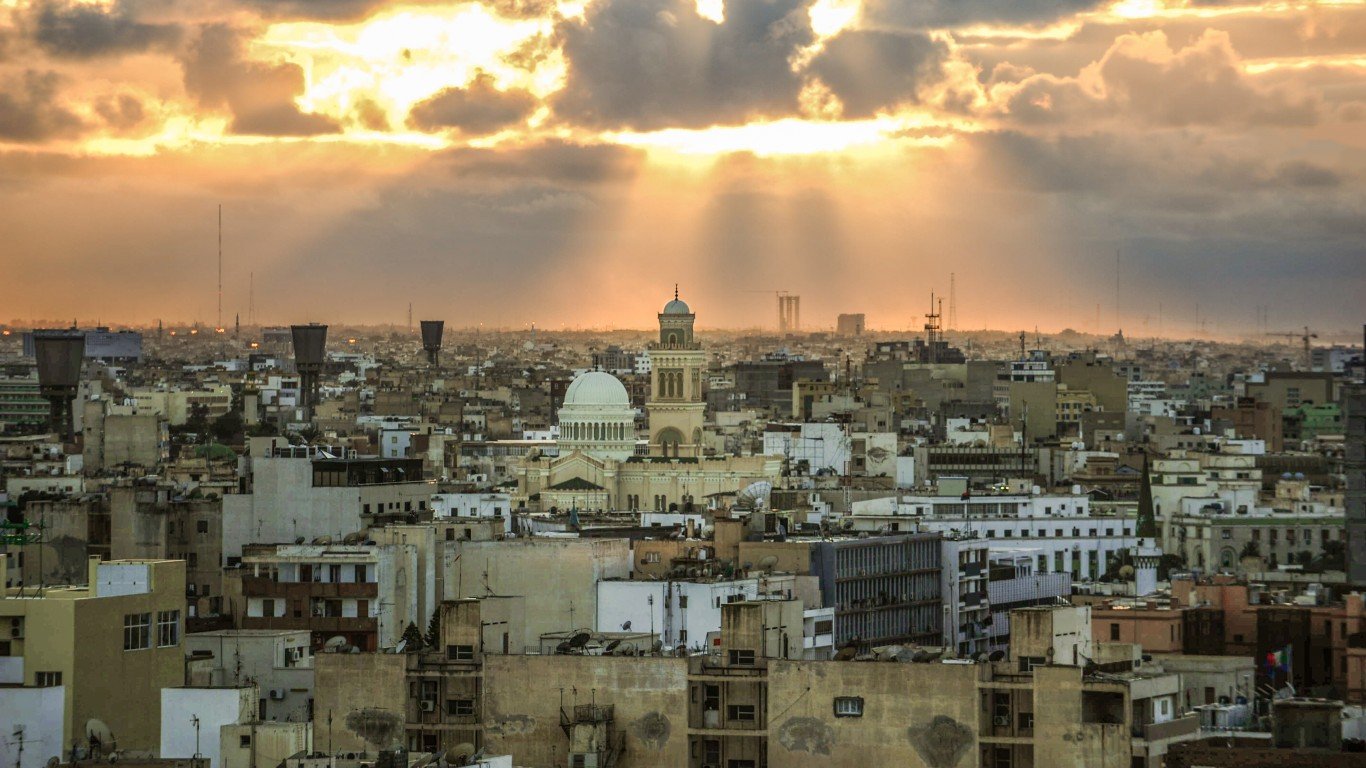
South Dakota
> GDP: $45.4 billion
> Country w/ similar GDP: Libya ($46.6 billion)
> S.D. population: 869,666 (Libya: 6.4 million)
> S.D. GDP per capita: $52,240 (Libya: $7,315)
South Dakota’s economic output is $45.4 billion, one of the lowest state GDP figures and roughly equivalent to that of Libya, a country on the northern coast of Africa. The country’s economy has struggled since leader Muammar Gaddafi was deposed in 2011, leading to a power vacuum that has caused the country to fracture politically.
[in-text-ad]

Tennessee
> GDP: $315.1 billion
> Country w/ similar GDP: Singapore ($310.0 billion)
> Tenn. population: 6.7 million (Singapore: 5.6 million)
> Tenn. GDP per capita: $46,925 (Singapore: $55,236)
Tennessee is 154 times larger than the island nation of Singapore and is home to 1.1 million more people. Still, Tennessee and Singapore have similarly sized economies, at $315.1 billion and $310.0 billion, respectively. On a per capita basis, Singapore is wealthier than Tennessee. One of the “tiger” economies of Asia, Singapore underwent an economic boom in the 1980s and 1990s. Today, it is one of the most open and developed economies in the world.
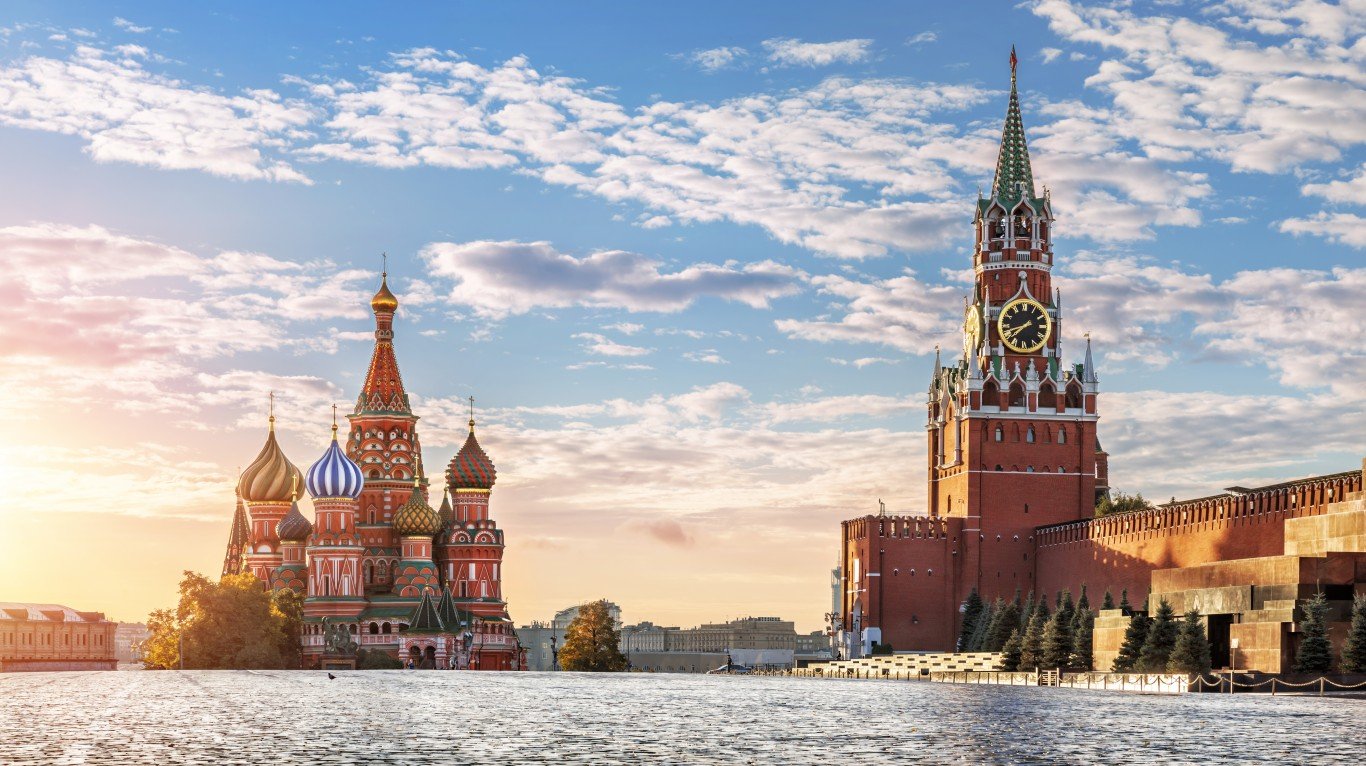
Texas
> GDP: $1.6 trillion
> Country w/ similar GDP: Russian Federation ($1.7 trillion)
> Texas population: 28.3 million (Russian Federation: 144.5 million)
> Texas GDP per capita: $57,077 (Russian Federation: $11,441)
The second largest state economy in the country, the GDP of Texas rivals that of world superpower Russia. Russia’s economy depends on gas, though not as much as many other nations on this list. About half of the country’s exports are petroleum. Similarly, Texas is the top oil and natural gas-producing state in the U.S. Though they have similar GDPs, Texas has a GDP per capita roughly five times that of Russia.
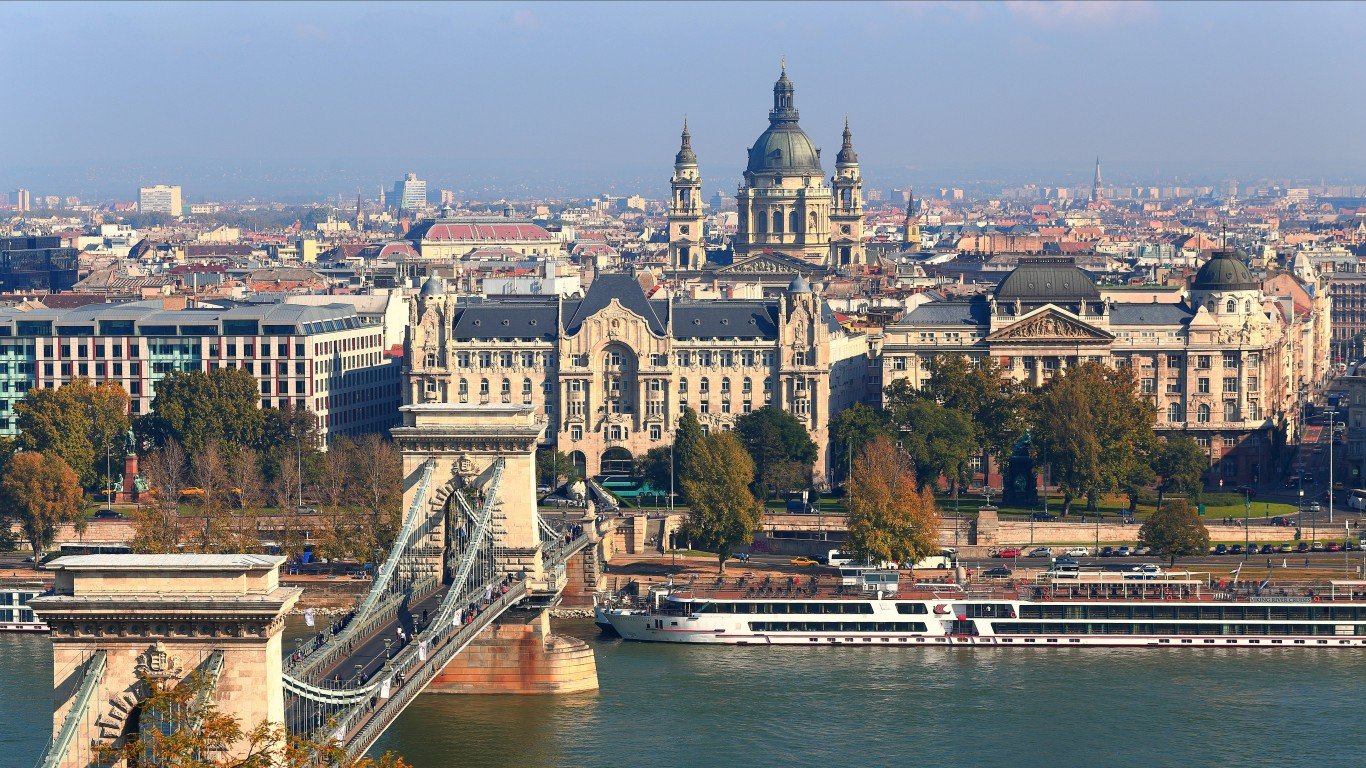
Utah
> GDP: $150.1 billion
> Country w/ similar GDP: Hungary ($153.1 billion)
> Utah population: 3.1 million (Hungary: 9.8 million)
> Utah GDP per capita: $48,376 (Hungary: $15,648)
Though the population of Hungary is more than triple the population of Utah, the European country covers a land mass less than half the size of Utah. Hungary has a varied economy, exporting different products like computers, cars, medical equipment, and more. The country is pulling out of a major economic contraction that started in 2009. Its GDP per capita is less than one-third that of Utah.
[in-text-ad-2]
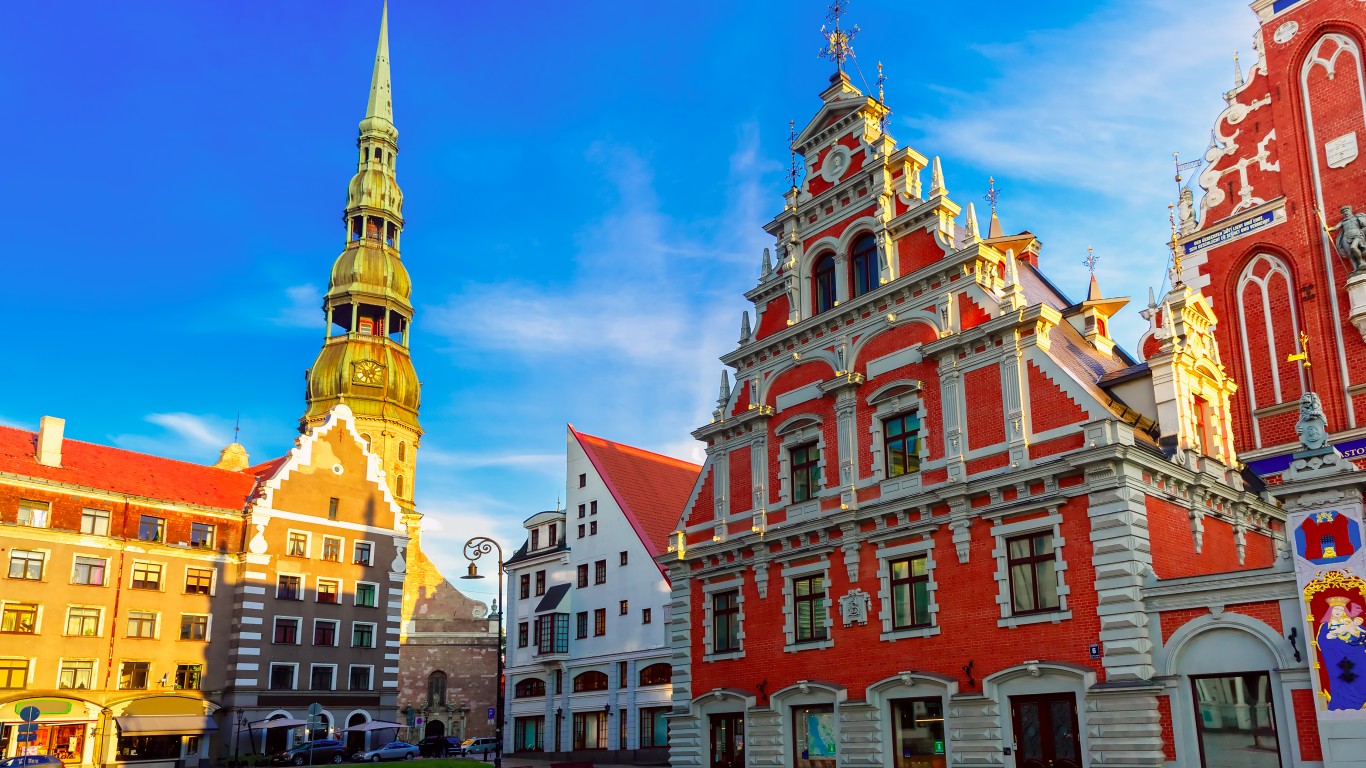
Vermont
> GDP: $29.6 billion
> Country w/ similar GDP: Latvia ($30.2 billion)
> Vt. population: 623,657 (Latvia: 1.9 million)
> Vt. GDP per capita: $47,408 (Latvia: $15,553)
Vermont has a $29.6 billion economy, nearly the same size as Latvia’s $30.2 billion economy. Latvia, a former Soviet republic in northeastern Europe, transitioned to a free market economy in the 1990s. Vermont’s economy is far more developed, generating the same output as Latvia with about a third of the population.

Virginia
> GDP: $463.6 billion
> Country w/ similar GDP: Nigeria ($460.5 billion)
> Va. population: 8.5 million (Nigeria: 190.9 million)
> Va. GDP per capita: $54,730 (Nigeria: $2,412)
Virginia has a massive $463.6 billion economy, in line with the total economic output of Nigeria, the most populous country in Africa. With much of Virginia within commuting distance to Washington D.C., the state is home to some of the largest defense contractors in the world. Nearly 16% of the state’s labor force is employed in the professional, scientific, and management sector, the largest share of any state.
Nigeria, meanwhile, is one of the world’s largest oil producers. Economic development, however, is hindered by political and social instability.
[in-text-ad]

Washington
> GDP: $480.9 billion
> Country w/ similar GDP: Norway ($481.8 billion)
> Wash. population: 7.4 million (Norway: 5.3 million)
> Wash. GDP per capita: $64,937 (Norway: $91,219)
Washington is one of three states, along with Massachusetts and North Carolina, that has an economic output most similar to that of Norway. Washington, particularly Seattle, has developed into a tech hub and is home to companies like Amazon and Microsoft. Norway recently developed into a major exporter of petroleum after discovering offshore reserves. Though Washington is one of the more productive states relative to its size with a nearly $65,000 GDP per capita, Norway’s per capita output of over $91,000 is greater.
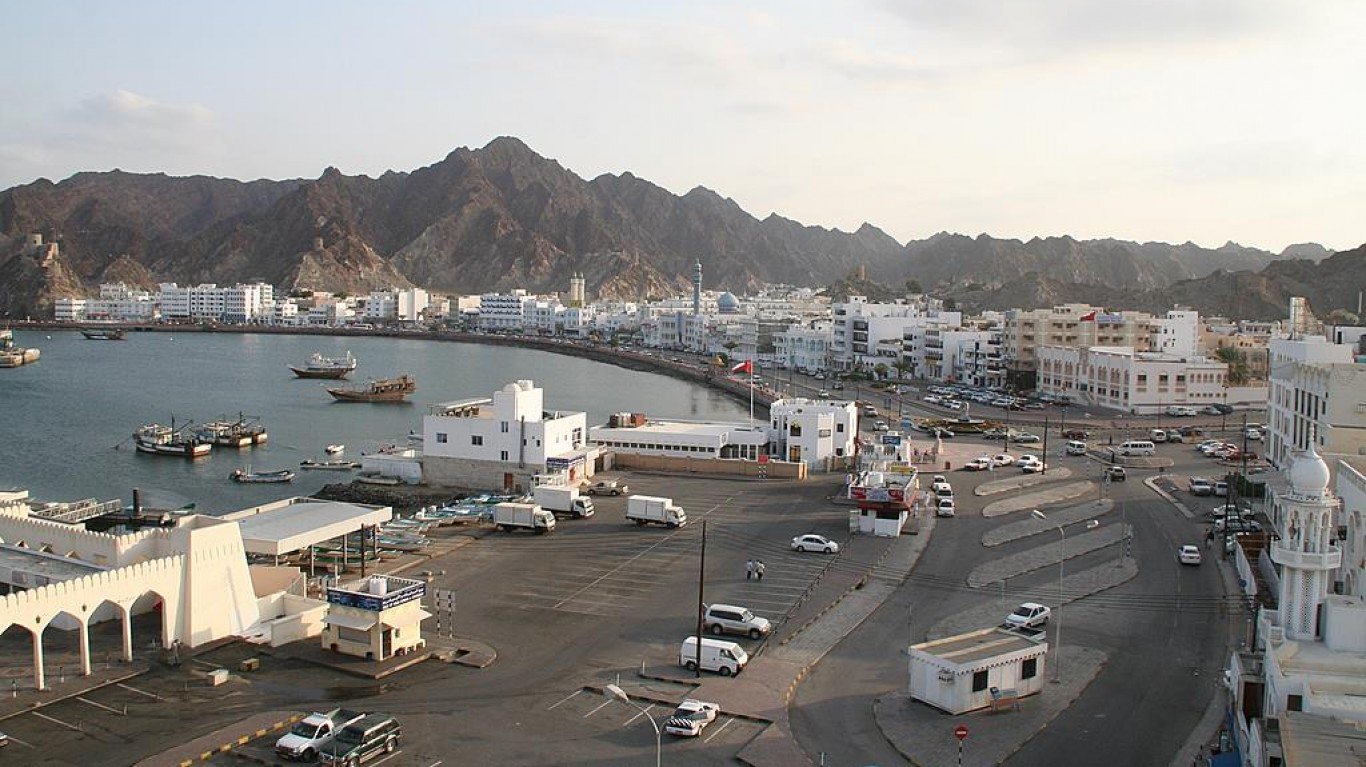
West Virginia
> GDP: $70.6 billion
> Country w/ similar GDP: Oman ($74.8 billion)
> W.Va. population: 1.8 million (Oman: 4.6 million)
> W.Va. GDP per capita: $38,860 (Oman: $16,144)
One of the nation’s leading coal producers, West Virginia’s economy is heavily based on resource extraction. West Virginia’s 2017 GDP of $70.6 billion is nearly in line with that of Oman, a Middle Eastern country with a $74.8 billion economy. Like West Virginia, Oman is also resource rich. Over half of its $31.2 billion in exports in 2017 were either crude petroleum, petroleum gas, or refined petroleum.

Wisconsin
> GDP: $292.3 billion
> Country w/ similar GDP: Israel ($297.4 billion)
> Wis. population: 5.8 million (Israel: 8.7 million)
> Wis. GDP per capita: $50,431 (Israel: $34,135)
Like Arizona, the country that has the closest GDP to Wisconsin is Israel. Wisconsin is nearly eight times the size of Israel by landmass, but it has a smaller population, and the two areas have a similar economic output of more than $290 billion. Israel’s top export is diamonds, worth over $10 billion in 2017. The relatively young country on the western shore of the Mediterranean Sea also exports billions of dollars worth of chemical products like medicine, pesticides, and fertilizer. Meanwhile, Wisconsin’s manufacturing industry employs 17.9% of workers in the state, well above the sector’s 10.1% national average employment.
[in-text-ad-2]

Wyoming
> GDP: $38.7 billion
> Country w/ similar GDP: Cote d’Ivoire ($39.5 billion)
> Wyo. population: 579,315 (Côte d’Ivoire: 24.3 million)
> Wyo. GDP per capita: $66,776 (Côte d’Ivoire: $1,626)
Wyoming has a $38.7 billion economy, nearly the same size as the economy of Cote d’Ivoire, or the Ivory Coast, a nation in West Africa. The largest exporter of cocoa beans in the world, Ivory Coast has a relatively well-developed economy and is wealthier than most countries in the region.
Wyoming’s economy is also largely resource based. About 40% of all coal in the United States is mined in Wyoming, and the state is also home to the largest uranium mining operations in the country.
Take This Retirement Quiz To Get Matched With An Advisor Now (Sponsored)
Are you ready for retirement? Planning for retirement can be overwhelming, that’s why it could be a good idea to speak to a fiduciary financial advisor about your goals today.
Start by taking this retirement quiz right here from SmartAsset that will match you with up to 3 financial advisors that serve your area and beyond in 5 minutes. Smart Asset is now matching over 50,000 people a month.
Click here now to get started.
Thank you for reading! Have some feedback for us?
Contact the 24/7 Wall St. editorial team.
 24/7 Wall St.
24/7 Wall St. 24/7 Wall St.
24/7 Wall St. 24/7 Wall St.
24/7 Wall St. 24/7 Wall St.
24/7 Wall St.
